 By Pepper Parr By Pepper Parr
March 23, 2015
BURLINGTON, ON
It is going to be a tough meeting.
The city will give the public a peek at what they have in mind for the Beachway Park at a meeting on April 7th at the Art Gallery of Burlington – start time is 6:30 pm
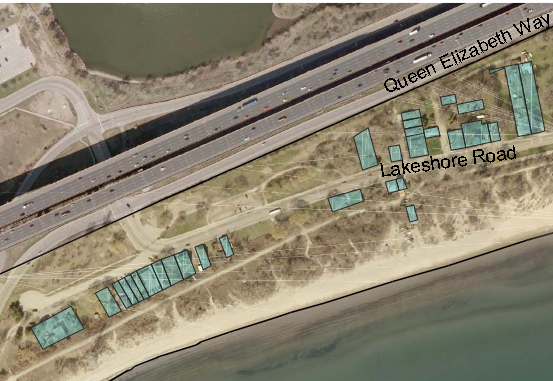 This is the location of the 30 homes the Regional government would like to at some point buy and demolish and turn into a park. The challenge the city faces in designing a park for the Beachway part of the city is – how long are the houses going to be in place?
How does a landscape designer put together a plan without knowing if a piece of land is going to be available or not?
The landscape planner on the Beachway file did most of the work for the City View Park on Dundas at Kerns Road. It is a very well designed park – Burlingtonians don’t get to use it all that much because of its location and will get to see almost none of it during the Pan Am Games this summer – it is being used for soccer practice by teams and there is no public admittance.
The challenge for the planner is – how does she put together a design that covers the park when 26 homes are still on the property?
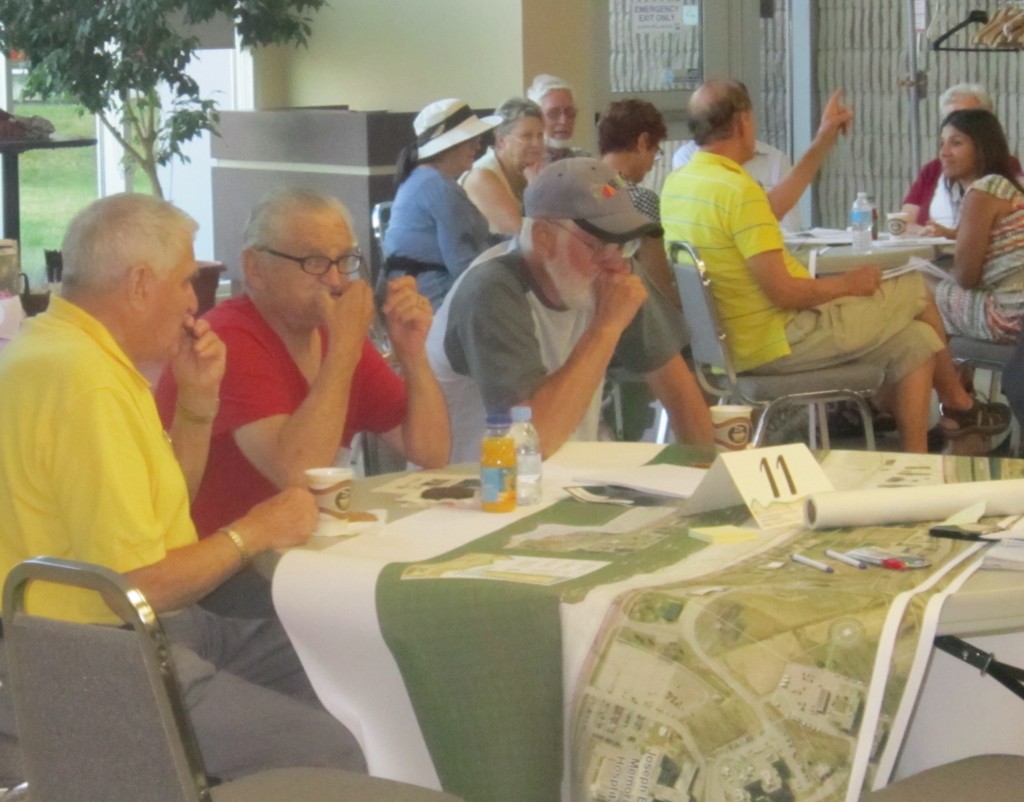 These Beachway home owners got to see drawings with houses on the maps – some of the design maps apparently don’t have houses shown. They assume a clean slate. The thinking that is reported to dominate the people doing the design is that the homes are not going to be there for all that long. There is a view that the Region should just get on with it and buy all the homes now and complete the destruction of that community.
The fight to keep the homes as part of a vibrant community was lost when Burlington wasn’t able to convince their municipal colleagues on Regional council that there was real merit to maintaining the homes the way the city of Toronto did with the Islands.
It was a long hard battle to keep a community on the Toronto Islands but the residents eventually won and today it is a quaint, safe livable community.
Burlington appears to have missed out on the opportunity to preserve something that is a part of both its history and its heritage.
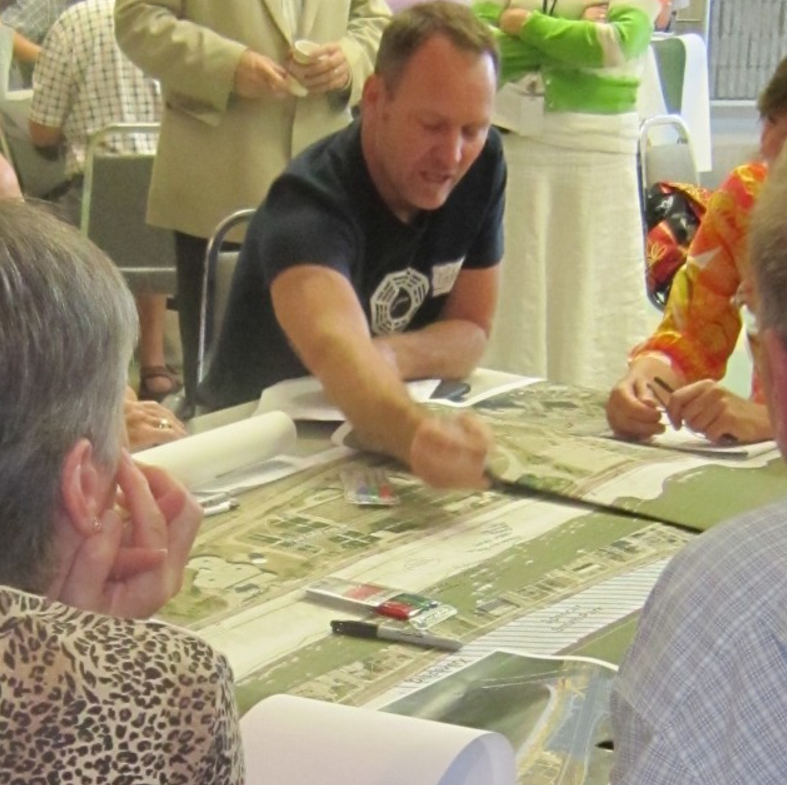 At previous public meetings the discussion was about what the community could look like – the discussion this time around does not include a community – just a park. At least one of the maps that will be shown will not have any of the houses on it – that will be used to show what the park could look like if all the houses were gone.
There are, we understand, plans to make the canal a bigger feature in the design.
The Regional government has consistently taken the position that there is a willing buyer – willing seller situation – any buyers that might have been out there are going to give up on the idea of living in that community once they see the plans.
That leaves those people who own homes sitting there like apples in a barrel waiting for someone to spear them and eat them.
The Region had “guestimated” that they would have to spend something between $300,000 and $400,000 to acquire each property.
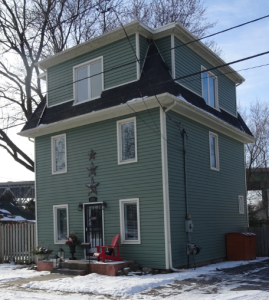 Sold for $600,000 + with the seller staying in the house under a two year lease. The most recent sale went through at more than $600,000. With the region prepared to pay what some say are more realistic prices and the plan for the park available to the public – it wouldn’t be unreasonable to assume that current owners will take what money there is on the table and call it quits.
There will be a couple of hold outs – that’s when expropriation will be used.
Expropriation has already been thoroughly discussed at the Staff level – it’s a tool that in this instance has political ramifications.
That isn’t going to make any difference to Ward 1 Councillor Rick Craven. He no longer talks to the Gazette so we can’t tell you what he has to say.
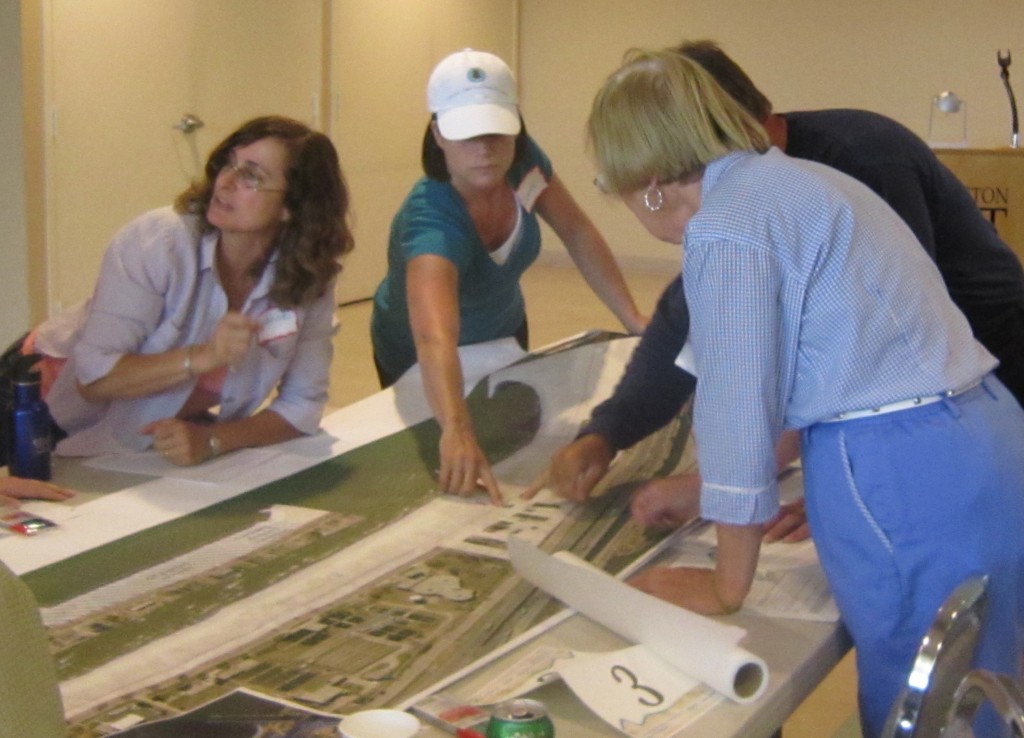 Laura Gillespie points out the part of the Beachway that affects her the most – the spot where her house is located. He is on record as not being a fan of keeping the homes in the park. Expect him to speak about the plan in glowing terms and as being the best thing for the city and the Region. That it is seen as a disaster for the people who live there and are his constituents does not seem to matter to the Councillor.
The Beachway has always had a bit of a down market cast to it. Many of the homes that were in place when the rail line went through were summer cottages that had been upgraded – usually not to the building code.
It had a sense of community to it but it also had a reputation. Ward 6 Councillor Blair Lancaster once told her colleagues that in her day “nice girls did not go to the Beachway’. We are not sure if that was before or after Ms Lancaster was made Miss Canada.
 Demolished in 1994  Demolished in 1990. The Region bought up the leases and tore down every last one of the houses that were on the lake side of the railway tracks. There are some ideas floating about that could make the Beachway more of a destination but Burlington requires more in the way of leadership vision for anything different or unique. Ideas need champions, people prepared to educate and lead a public.
Burlington doesn’t have enough of that around the council table. These things take time.

 By Pepper Parr By Pepper Parr
March 18, 2015
BURLINGTON, ON
Part 1 of a 2 part feature.
It was a gathering of the true believers – they met at McMaster University’s DeGroote campus in Burlington to listen to environmental advocate lawyer David Donnelly, Oakville Mayor Rob Burton, Suzuki guy and female planner who focused on what they see as a threat to Ontario’s Greenbelt.
It was defined as an occasion to celebrate and a time to hunker down and make sure that the gains made are not taken away as the Ministry of Municipal Affairs and Housing (MMAH) holds a series of Town Hall meetings across the province.
It is a delight to listen to Oakville Mayor Rob Burton talk about how that town managed to “green” its Council and to listen to David Donnelly proselytize about the environment.
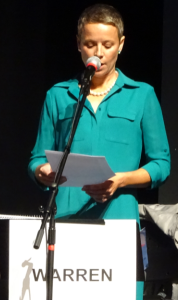 Vanessa Warren, founder of the Rural Burlington Greenbelt Coalition, ran as a candidate in the last Burlington municipal election. Vanessa Warren, founder of the Burlington based Rural Burlington Greenbelt Coalition (RBGC) bounced about the room introducing people and keeping things going.
Warren first crossed Burton’s path when she was delegating to Halton Regional Council on the Burlington Air Park problems. At that time Burton explained to Warren that she had more clout with the Air Park issue than Regional Council.
Several months later, Warren was sued for libelling the Air Park ownership and hired David Donnelly to defend her. Full disclosure: The Gazette is a party to the libel law suit – but we are not being defended by Donnelly. The evening was almost a family get together.
The purpose of the meeting was to get the community ready for the provincial Town Hall meetings that are looking at the way the province and its municipalities do land use planning.
The Smart Growth for Communities Act – Bill 73 is the focus point – does the bill give the environmentalists what they are looking for and can the developers live with it.
Rob Burton, in a style that is all his own explained how to make a city council green.
 Oakville Mayor Rob Burton “Back in 2006” said Burton, “we thought if we could elect one green councillor we were on our way to saving the planet. They elected Allan Elgar.
About 18 months into his term of office Allan said to his green cohorts – one man isn’t enough. Come the 2010 election they got three greens on the Oakville city council.
Eighteen months into that mandate the group came to the realization that three wouldn’t do it – so in the 2014 term they elected seven greens.
Rob Burton feels he is on his way and is ready to plunge into the MMAH Town Hall meetings.
Burton explained what Oakville and to some degree the Region has done to protect its environment. What he didn’t tell the audience was how Oakville pressured the provincial government to keep a gas plant out of the municipality – the fallout from the way that was done cost former Premier Dalton McGuinty the government he had then and continues to plague current Premier Kathleen Wynne.
Burton, talking to an attentive crowd – 125 people with more than half from outside the Region, said that while there is a provincial policy and a Regional policy” we in Oakville have carved out Natural Heritage sites (NHS) that fit in with and compliment the Regional and provincial policies.
Councillors Taylor and Meed Ward were on hand from Burlington.
Halton Region Natural Heritage System (NHS) covers 48,000 hectares in the greenbelt, farmlands and urban areas
The Halton NHS goes beyond provincial designations by adding new key features for permanent protection of significant woodlands; they have created buffers and linkage corridors to connect the key natural heritage features.
 There are development corporations that would love to put residential housing on the Escarpment – not on say the environmentalists. Burlington is currently working on a vision for Mt Nemo plateau and undertaking a Heritage Conservation District Study. Nemo 7G/PERL formed a seven-generation, (150 years) vision for the plateau. Mt. Nemo has been identified as one of the best examples of high diversity and functioning ecosystems in the GTA-Hamilton area.
From October 2013 to January 2014, the government undertook province-wide consultations on the land use planning and appeal system, and development charges system to ensure both systems are predictable, transparent, cost effective and responsive to the changing needs of our communities. The government is responding to comments received through the consultations and has announced proposed legislative amendments to the Development Charges Act, 1997 and the Planning Act.
If passed, Bill 73 – the proposed Smart Growth for Our Communities Act would give residents more say in how their communities grow, set out clearer rules for land use planning, give municipalities more independence to make local decisions and make it easier to resolve disputes.
For example, residents would be better involved at the beginning of the planning process and have a say in the future of their communities. Municipalities would need to set out in their official plans how and when the public would be consulted, and would also need to explain how public input affected their planning decisions.
The bill would also: give municipalities more opportunities to fund growth-related infrastructure, like transit; make the development charges, section 37 density bonusing and parkland dedication systems more predictable, transparent and accountable; and support higher density development to create jobs and grow the economy.
The province will be setting up working groups of stakeholders to review further more complex development charges issues, and to take a considered look at some land use planning elements, and propose solutions.
Both Burton and Donnelly point to significant successes and believe the tide is turning and the tipping point is at hand.
 This little guy was a significant part of the end of quarrying in rural Burlington. They point to the October 11, 2012: Joint Board decision that dismissed Nelson Aggregate Co.’s applications for a proposed 26 M tonne quarry on 82 ha site. That decision focused on impacts to Jefferson Salamander and its habitat in the context of the Niagara Escarpment Plan (NEP)
In September 17, 2014 the Niagara Escarpment Commission (“NEC”) voted in favour of an outright ban on new quarries in the NEP; that vote went 7 Commissioners in favour, 5 Commissioners against
The 2015 Greenbelt Plan Review is something environmentalists have been waiting for – the Town Hall meetings are just one part of the process. Many people take considerable comfort from the appointment of former Toronto Mayor David Crombie being appointed chair.
This process is something to be watched.
Part 2 of a 2 part feature.

 By James Smith By James Smith
March 7, 2015
BURLINGTON, ON
Sometimes, little noticed somewhat boring announcements by government are the ones that pack the biggest punch. Yesterday’s announcement by Minister Ted McMeekin that Ontario intends change to how we’ll plan, build, and pay for developing cities in Ontario is one such announcement.
The way Ontario is built and developed is about to change; I think this will be a very welcome. First let me declare my bias, I’m a Founding Member of BFast (Burlington for Accessible Sustainable Transit), and as a design consultant I often work on projects for both public and private developers. I feel the changes announced by Minister McMeekin yesterday may mean modestly more work for me and my clients.
If these changes live up to the billing, changes to Smart Growth, land use planning and development charges have the potential to be a seismic shift on how cities are built for years to come and this affects us all. The coming changes will radically impact how we go about urban growth in Ontario on a scale as large as the introduction, ten years ago, of The Green Belt. If the legislation lives up to the press release, the Province will put teeth into its Smart Growth policy and Municipalities will need to pull their weight.
So far Smart Growth is a policy many municipalities, including Burlington, give just lip service. Professional planners and drafters of Official Plans write elegant documents, but City and Town Councils frequently ignore their more lofty goals. With this legislation Minister McMeekin is saying Municipalities will be held to account, and will need to live up to the Goals of Smart Growth. Long overdue.
 This change is about the kind of building projects we’ll see built in Ontario and how we will pay for the stuff we build. I suspect that members of Burlington and other City councils who subscribe to the failed dogma of Libertarianism won’t like this legislation one bit. To them I say: “suck it up princess, the free ride is over”. Specifically these Planning Act Changes propose to: This change is about the kind of building projects we’ll see built in Ontario and how we will pay for the stuff we build. I suspect that members of Burlington and other City councils who subscribe to the failed dogma of Libertarianism won’t like this legislation one bit. To them I say: “suck it up princess, the free ride is over”. Specifically these Planning Act Changes propose to:
• Ensure residents are better consulted at the beginning of the planning process for new developments.
• Encourage residents to provide feedback on the future of their communities.
• Help municipalities resolve potential planning disputes earlier, reducing involvement of the Ontario Municipal Board in local disputes.
• Extend the review of new municipal official plans to 10 years, instead of the current five-year cycle
• Providing municipalities with more control and stability over their planning documents. Once a municipality establishes a new official plan, it would be frozen and therefore not subject to new appeals for two years unless changes are initiated by the municipality. A community planning permit system once established by a municipality would not be subject to any appeals of private applications for five years.
• Clearly defining what constitutes a minor variance (a small change from a zoning bylaw).
Better consultation with residents early in the development process and getting their feedback are welcome, long overdue changes. The challenge will be to break down the walls of NIBYism; no small task. For at least seventy years North America has embraced suburban sprawl funded by, more sprawl.
Leigh Gallagher, in her book The End Of The Suburbs outlines how North Americans have the car-centric suburban landscape in their DNA and is our expectation of where we live. Both Gallagher and Smart Growth talk about breaking this unsustainable cycle. The proposed changes to the Act will have to help with this understanding of what Smart Growth means, so residents will need to understand this shift when proposals are brought forward. As, or more importantly, the development industry will have to change their business model too.
 Six houses identical to this one were torn down on land that was part of the Veterans Land program – the lots were assembled and the infill shown below built. Boilerplate infill projects will no longer be acceptable. Projects will more and more have to reflect an individual neighbourhood’s character and residents taste and long-term expectations for their community. Budgets for new projects will therefor need to change as removing the hated OMB from most planning disputes will mean more money being spent on public meetings and Architects’ fees and less time on Lawyers’ fees. In my experience, anytime more thought goes into a design and less time is spent on legal wrangling makes for a better project.
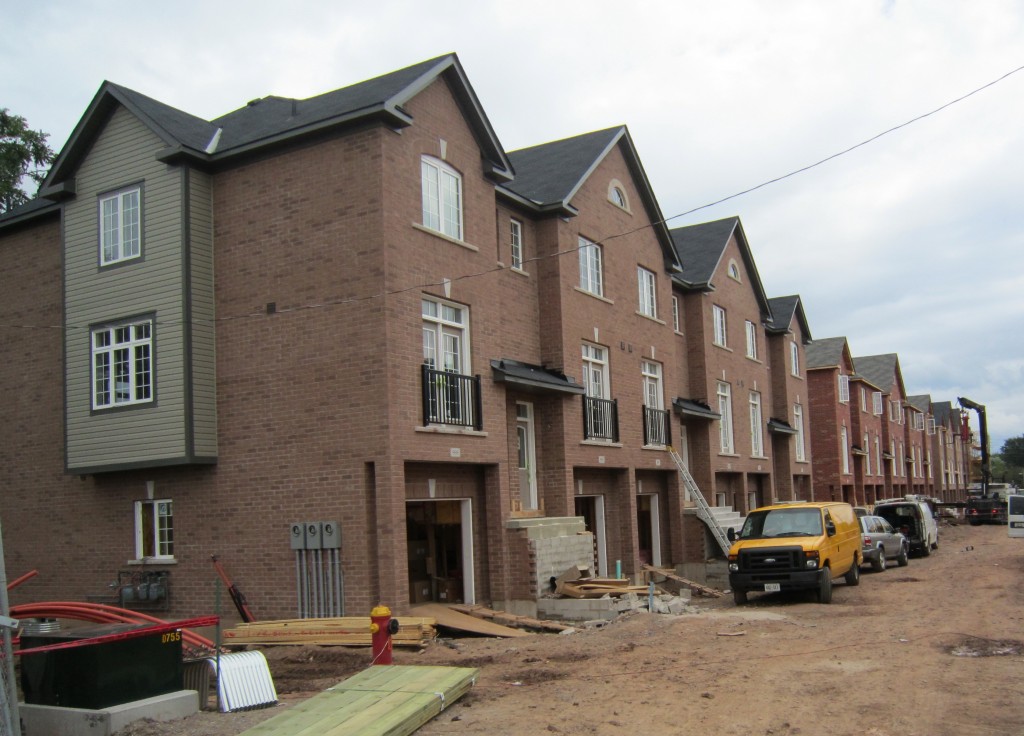 Fifty eight units were built on land that previously had six homes on it. Tough to find a back yard in this infill project. The ten year cycle for Official Plans has potential positive benefits as it will reduce the time Cities and Towns spend on Official Plans and free up those staff resources. No only is limiting the involvement of the OMB of great news, these changes will mean fewer Municipalities, will do their city planning by Official Plan Amendments. Burlington specifically has for at least 25 years engaged in planning by Official Plan Amendments rather than relying on either the Regional or City’s Official Plan. Councils often are blinded by developments that have actually cost the Municipality money in the long run as the Official Plan Amendments often is at odds with the official plan, these changes will force the Development industry to do better planning, spend more on Designers and less on Lawyers.
Development Charges are set to be changed in the following fashion:
• Help municipalities recover costs for transit services and waste diversion.
• Create clear reporting requirements for capital projects municipalities financed though development charges, as well as section 37 of the Planning Act related to density bonusing and parkland dedication.
• Municipalities would be required to follow reporting requirements that reflect best practices and detail to the community how money from development charges is spent.
• The government would create better reporting requirements for municipalities collecting money under section 37 of the Planning Act related to density bonusing, and related to parkland dedications, which details how the funds are spent.
• Development charges would be payable at the time the first building permit was issued for a building so that developers could be certain of the cost.
• Municipalities would be required to better integrate how development charges fit with long-term planning, including local asset management plans.
• The government will help municipalities identify and share their best practices on using development charges to address local planning and financial objectives.
• There would be more stringent reporting and greater oversight of any funds or municipal charges on new developments that fall outside what is allowed in current legislation
Development Charges can be a useful tool to reflect the real capital costs of any building project on a municipality. Planner Pamela Blais in Perverse Cities clearly outlines that the real cost to the municipal taxpayer of urban sprawl is not presently accounted for in many North American jurisdictions. Development Charges attempt to make a project pay for the real cost of the capital costs a new project represents.
While Transit and Waste diversion were not specifically accounted for in the previous Act they can be funded under more general categories. Specifically calling these items out is a good step. The challenge will be to use Development Charges to limit Greenfield, or make it pay for the burden it puts on a Municipality while simultaneously not acting as a brake on positive and creative infill development.
So there needs to be the ability for Municipalities to bracket Development Charges accordingly.

 By Pepper Parr By Pepper Parr
March 5, 2015
BURLINGTON, ON
Ontario is proposing reforms to the Planning Act and the Development Charges Act that would give residents a greater say in how their communities grow and would provide more opportunities to fund community services like transit and recycling.
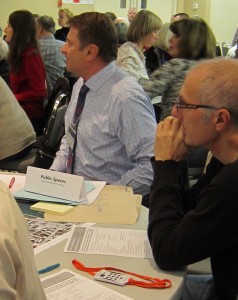 City planner Bruce Bruce Krushelnicki will undoubtedly applaud the proposal the have Official Plan Reviews done every ten years instead of the current five. The proposed Planning Act changes, if passed, would:
Ensure residents are better consulted at the beginning of the planning process for new developments.
Encourage residents to provide feedback on the future of their communities.
Help municipalities resolve potential planning disputes earlier, reducing involvement of the Ontario Municipal Board in local disputes.
Extend the review of new municipal official plans to 10 years, instead of the current five-year cycle.
 If passed the Bfast people (Burlington for Accessible Transit) will burst with Joy! – and probably have to have Pacemakers installed to still their beating hearts. If passed the Bfast people (Burlington for Accessible Transit) will burst with Joy! – and probably have to have Pacemakers installed to still their beating hearts.
Burlington has always had a confusing relationship with transit – most people don’t use it – and council doesn’t like spending for a service that isn’t used all that much
Changes to the Development Charges Act, if passed, would:
Help municipalities recover costs for transit services and waste diversion.
Create clear reporting requirements for capital projects municipalities financed though development charges, as well as section 37 of the Planning Act related to density bonusing and parkland dedication.
Working groups of stakeholders will review and consider further more complex land use planning and development charges issues, and propose solutions.
The proposed amendments are based on input from across Ontario including more than 20 public workshops and stakeholder meetings held from October 2013 to January 2014.
More than 1,200 submissions on the land use planning and appeal system, and the development charges system were received during the reviews.
Approximately 200 of Ontario’s 444 municipalities use development charges.
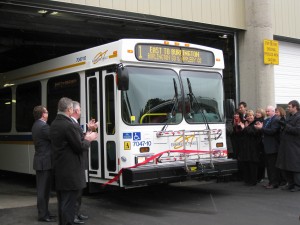 Province appears to want more public input on transit decisions – might mean crating a new transit Advisory Committee. We scrapped the one we had. The announcement from the provincial government this morning are proposals that will have to be debated and it will take some time for them to work their way into the way business is done in the province. If passed they have the potential to make significant changes in the way transit development gets done and the rile the public can play.
The question left hanging for Burlington on this one is: Will we have our Official Plan revised and voted on before the province makes these proposals law?
Ten years between Official Plan reviews must have resulted in huge sighs of relief in the city’s planning department.

 By Pepper Parr By Pepper Parr
February 28, 2015
BURLINGTON, ON
Revised
For some reason the Burlington Beachway seems to be making the news
 The community used to straddle the railway line that ran beside the lake – it once had more than 200 homes. Today there are just 30 left and they aren’t at all interested in selling or moving.
Councillor Meed Ward was interviewed on Cogeco Community television and mention was made of the very unsatisfied residents who felt they were not going to ever see the true equity in their homes.
That led Cogeco reporter Krista Sharpe to getting out into the community with her camera and asking questions.
Sharpe met Helen Skinner who has very strong opinions on what the Region and the City are doing to the Beachway community and has never been at a loss for words.
Form your own opinion – listen to Cogeco.
 The Region budgeted as much as $400,000 to buy |Beachway homes – this one was sold for $600,000 with the owner given the right to remain in the building for two years. What the public hasn’t been told all that much about is the work going on within the Burlington Parks and Recreation department – they are the people doing at least the early part of the design work of the proposed park.
The Beachway issue is: what kind of a community does the public want? The public is vaguely aware that the Region is prepared to buy the homes and if what Craven has to say is true they are actively “courting”‘ those home owners – you could say they are picking them off one by one. What the general public really isn’t clued into is what will eventually happen to the Beachway if the Regional policy gets carried out.
Councillor Craven says the home owners are not being pushed out and that they have been kept fully informed – that’s not the view one gets from council candidate Katherine Henshell who says that because of the zoning and the prospect of homes being tied up in red tape – residents can’t find willing buyers – and that depresses the value of their homes.
Henshell argues that the only buyer is the Region
That might be the case but the Region estimated the houses could be bought for about $300,000 each – the most recent sale was for $600,000.
The Beachway situation has always been complex – do the views of Craven, Skinner and Henshell impact what you think?

 By Pepper Parr By Pepper Parr
February 17, 2015
BURLINGTON, ON
Two oddities: the word neighbourhood does not appear in the current Official Plan and Shoreacres Blvd is not within the boundaries of the Shoreacres Community Study.
What isn’t at all odd is that the people who live in the community want some say over the rate at which their community undergoes a change.
The Community and Corporate Services Standing Committee was reviewing a report from the Director of Planning on the the option of a Character Area Study for Shoreacres as part of the Official Plan Review.
 Neighborhood character studies have taken on a bit or a social cachet in Burlington. Two years ago there were two of the things launched; one at Indian Point, which went nowhere and the residents want to get out of what they started. Neighborhood character studies have taken on a bit or a social cachet in Burlington. Two years ago there were two of the things launched; one at Indian Point, which went nowhere and the residents want to get out of what they started.
A second community character study was launched in Roseland where small developer/contractors were roaming the streets looking for property they could purchase and divide into two lots or build what have come to be called monster homes.
In the spring of 2014, the demolition and rebuild of a dwelling in the Shoreacres Community led to a grassroots community discussion about a growing trend of redevelopment and its related impacts in the area. This community discussion took place through informal gatherings, petitions and conversations with media.
The Director of Planning was instructed to report back to Development and Infrastructure Committee in Fall 2014 on whether to conduct the study based on the following:
scope and timing of the study and the impact on the completion of the Official Plan Review Process
additional resource requirements
preliminary policy directions, zoning and design guidelines.
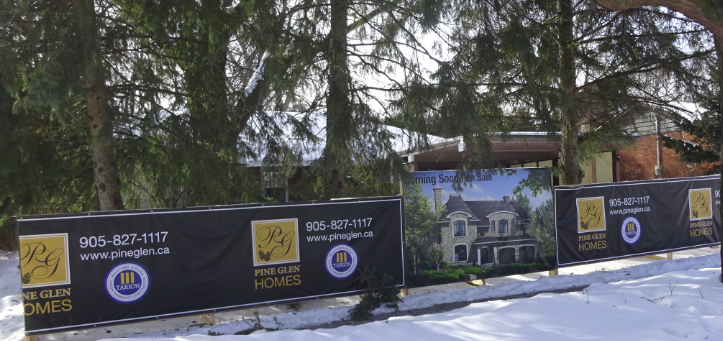 Selling the dream. The house proposed is seen as so out of design and proportion from the house behind the hoarding by the residents – they fear the character o their neighbourhood will be changed too quickly, The planners organized a preliminary community meeting to consult with residents regarding the primary issues facing the neighbourhood. Staff concluded that the built form and housing stock in a section of Shoreacres is relatively homogeneous. While redevelopment has been occurring in the larger neighbourhood that comprises Shoreacres (generally described as south of New Street, west of Walkers Line and east of Appleby Line), there is a particular area within Shoreacres that has similar characteristics that distinguish it from other areas of Shoreacres.
This area can generally be described as those properties located south of Spruce Street and north of Lakeshore Road, on both sides of Goodram Drive on the west and on both sides of Juniper Avenue on the east. Common features within this area are, most notably, the predominance of bungalows and absence of two-storey dwellings, low pitch rooflines, mature trees, the absence of sidewalks on some streets and the usage of siding as a common cladding material.
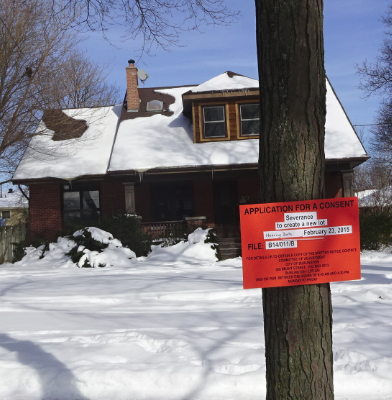 This resident seeks consent from neighbours to sever their property Staff, in consultation with the Ward Councillor, established an initial boundary for this area comprising approximately 185 homes and mailed out meeting notices and questionnaires to these addresses.
A community meeting to discuss recent development in the Shoreacres Community took place last July – 65 people attended, which some residents pointed out later amounted to one third of the residents in the study area – more than the percentage that voted in the municipal election.
Staff took the residents through the basics of planning and gave them an update on the Character Area Study for Roseland and Indian Point.
The primary issues that were raised at the meeting and through questionnaires, phone calls and emails can be summarized into the following topics:
a) There is inadequate public notification for demolitions, rebuilds and minor variance applications
b) There is inadequate protection of existing mature trees on both public and private property
c) The size of the study area as shown on the meeting invitation is too scoped
d) The architectural style of new homes (modern architecture, flat roofs) is incompatible with the existing neighbourhood
e) Redevelopment has adverse impacts on the privacy of adjacent property owners
f) The permitted building height (10 m for peaked roof residential dwellings) is incompatible with existing dwellings
g) The permitted number of storeys (2 storeys maximum) is incompatible with existing dwellings
h) The applicable Zoning By-law provisions for corner lots are inappropriate for the neighbourhood
At the community meeting, staff provided several responses regarding the above concerns as summarized:
a) Public notification requirements for development applications are established in the Ontario Building Code and the Planning Act and, for Ontario municipalities, there are no legal notice requirements that accompany the issuance of site plan approval, demolition permits and/or building permits. The public notification requirements for minor variance applications are set out in the Planning Act and implemented by the City. Specifically, a sign is posted on the subject property and notice is mailed to all property owners within 60 m of the subject application.
While the various act set out what is required there is no reason why the planning department can’t do more than the acts call for
b) The City of Burlington does not have a private tree by-law that can protect trees on private property. The City recently considered the implementation of a Private Tree By-law in July of 2013, but did not proceed with this initiative. The protection of trees on public property is managed through the site plan process and the protection of boundary vegetation is protected through the Forestry Act and reviewed during the site plan process.
c) The study area shown on the meeting invitation is a preliminary study boundary and is still subject to change.
d) Architectural style cannot be regulated through the Planning and Building Department, but the Urban Design Guidelines for Low Density Residential Zones and the site plan process allow for review of architectural elevations and an opportunity to influence architectural style with the objective of ensuring compatible development.
e) (e-h) The concerns relating to privacy impacts, building height, number of storeys and corner lot zoning provisions all relate to the existing Zoning By-law requirements that apply to this area. During the meeting, staff noted that a zoning review could be conducted by City staff to determine whether or not changes to the Zoning By-law would assist in managing some of the changes being experienced by the neighbourhood. Based on the comments that have been received to date, staff is of the opinion that a zoning review, including additional public consultation, in this area is warranted.
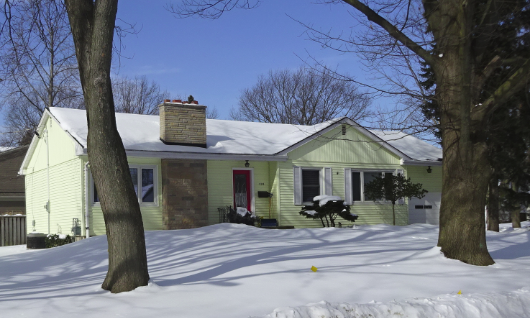 Another large, spacious corner lot. Mayor asked what the average size of these houses was – between 1200 and 2200 sq. ft. but Faccenda said the neighbourhood was not yet ready for significant development. Albert Faccenda said a neighborhood will look like what the people who live there want it to look like. People sell their property and get the best price they can and developers build on the property they bought. We build what the market wants he said. He added that the present bylaw would allow 7 to 8 thousand sq. ft. homes; that sent a shudder through the council chamber.
Councillor Meed Ward asked what Faccenda wanted to see changed – the lot coverage could be more generous he replied. A bungalow get 35% lot coverage; a 1 1/2 storey can have up to 30% coverage and a two storey gets 25%
Strategy/Process
The city is currently conducting a Character Area Study for Roseland and Indian Point as part of the Official Plan Review. Significant insight has been gained as a result of the consulting team’s work and staff is recommending a study for the Shoreacres neighbourhood with narrower scope.
Subject to Council approval of the Terms of Reference, the scope of the Shoreacres Study would identify the compatibility impacts of recent development within the neighbourhood, and determine what, if any, measures should be taken to modify policy, zoning and development application process (e.g. minor variance or site plan applications).
The proposed study will be lead independently of the Official Plan Review. Any Official Plan policy amendments that may arise from this study would be conducted as a City- initiated Official Plan Amendment. This project could be instructive to the upcoming Zoning By-law Review, particularly for residential neighbourhoods south of the Queen Elizabeth Way
The Shoreacres community, as defined in the reports is certainly very distinct. |Mary Alice St. James said there were more than 40 corner lots in the area which gives developer/contractors opportunities to put much larger houses into the community and fundamentally changing the look and feel of the streets.
The community is one of the most desirable and priciest in the city. Ken Crew, who delegated, said he and his wife needed ten years to put together the money needed to buy a house.
They like their community just the way it is and while they say they are not opposed to development they don’t want to see all that much in the way of change. The developer/contractors love the area – they can sell almost anything they build at a very pretty price.
The question really comes down to – how much say do the people in a community get to say about what is permitted in the way of new construction.
The houses are not small; the lots are not small, however most are not large enough to be divided.
At what point do the homes in place now become outdated and no longer meet the needs of new families?
Is the character of a neighbouhood something municipal bureaucrats should be protecting or should the market determine what can be built and sold for a profit?
Director of Planning Bruce Krushelnicki is very sympathetic to the interests of the residents of the community. His planner Rosa Bustamante thinks it is more of a zoning exercise – the residents see their community being chewed up by economic interests.
Aldershot has much the same kind of housing on the water side of Plains Road west of King Road.
 This is the community the residents want to conserve – their hope is that a neighbourhood character study will result in zoning or bylaws that keep that exists. Niagara on the Lake has zoning and bylaws that determine what the look and feel of the streets in the commercial core of that city will look like – and they keep a very tight rein on what gets done. That community is a destination and is good business.
Does a small neighbourhood deserve the same kind of attention? The third of the community that showed up for the meeting, in the middle of July when many people were on vacation.
What do the residents of the community want? There were just two delegations. Ken Crew, a long time resident who was joined by his neighbour Ron Fleming
“To our neighbourhood, your approval of a City-funded and timely Character Study is of incredible importance he said.
“We have followed with great interest and support the development of the Character Study for Roseland and Indian Point. However, we are not Roseland or Indian Point. Our values and needs, while sharing some commonality with the Roseland study, are specific and unique to our mature neighbourhood.
The vast majority of the homes are smaller bungalows, with some 1 ½ storey homes and more recently a few bungalofts. There is also a very strong sense of community within this group of taxpaying homeowners.
“More recently however, our area, like others in Burlington, is under constant attack from developers with no ties to the local area or its residents, who are simply buying up the existing mature homes, demolishing them, and replacing them with the largest monster homes the city will allow under the current bylaws and regulations – or buying up corner lots and severing them for multiple large or monster homes. Their sole interest is profit, not the residents.
“A prime example is the new home recently erected on Oak Crescent, approximately 3 times the size of all other homes in the area, dwarfing its neighbours, with wrap-around large balconies, ruining the privacy of all homes surrounding it. It totally destroys neighbourhood character and streetscape and has reduced the existing tree canopy.
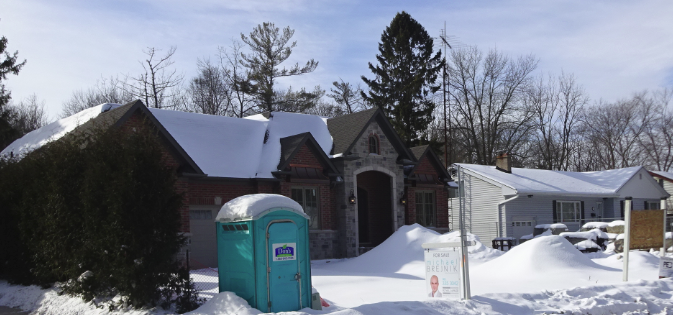 Residents in the community don’t see how this new home fits in with the bungalows in place now. And that porta potty has to go. “The footprint of the original corner house was changed and flipped 90 degrees in the opposite direction, while all of the plans and changes were done without the existing residents being aware of the changes, and without having any opportunity to provide input or discussion on this new monster home.
As well as being highly passionate about the character of the area we live in, we are also quite aware that change in our neighbourhood is inevitable, and in fact we have no serious opposition to change. We are very open to the proper, controlled, and measured changes that can be done without compromising the values we hold so dear. We know the City needs an effective and enforceable set of rules to control development and we want to work with, not against city planners to develop the appropriate set of rules to retain our unique community character. That is why this study is so critical.
“Burlington is a great place to live as recent studies have shown, and we are proud to be citizens of this excellent community. BUT, if City management does not recognize the rapidly increasing levels of citizen concern and involvement, particularly in the housing sector – whether it is the demand for Character Studies, the plans to build 28 story buildings in the wrong areas, or building large developments in areas where we already have major unresolved problems, like sewage and drainage, then we run the risk of allowing the destruction of some of the very core principles and characteristics that so many resident taxpayers find so vital to their continued happiness and desire to stay here as long term residents. The uniqueness of these neighbourhoods is a large part of what makes Burlington such a great place to live.”
 Another corner lot – this one on Lakeshore Road. The owner wants you to call them. “Time is of the essence. We have little time left to save this truly unique neighbourhood. Our earlier attempts to obtain an interim by-law to restrict monster homes in our area were unsuccessful, so we recognize this timely Character Study is our only option. “
Albert Faccenda a developer/contractor who has built eight homes in the community said there is no market for bungalows in Shoreacres; that he built one and lost his shirt. The Faccenda statements were in direct contract to what everyone else was saying. Faccenda finds that to be the case on most of the occasions he speaks. He told the residents of Roseland that their 100 foot lots were ’dinosaurs’ or more correctly, properties he would like to purchase and redevelop. He told Indian |Point residents that the Character Study being done in that neighbourhood was going to devalue their property.
Mary Alice St. James, an elementary school principal and a community resident gave a polished presentation extemporaneously – and made all the points that had to be made. She stressed that people want to move into the community and she doesn’t believe they want to move in and build homes that are out of character with what is already in place. “They wanted our neighbourhood” she said. “The situation we are faced with now is not nice” she added.
Councillor Craven said that while he appreciated the St. James passion “it is exactly what we saw at Indian Point but “once people got into the issues they got a better sense as to what could be done and at Indian Point they decided they didn’t want this study to go any further.”
 On one of the coldest winter days – the people in the community still get out with their dogs for what is a brisk walk. Craven said he thought “this issue may become less clear than you think it is now” referring to the Shoreacres residents.
Councillor Sharman was curious to see the outcome and added that he “was not comfortable with the way we are going about this”.
But they are going to “go about it”. The decision to proceed with the study will be made at a city council meeting before the end of the month.
Right now this Council has to determine just what the 2015 budget is going to look like.

 By Pepper Parr By Pepper Parr
February 6, 2015
BURLINGTON, ON
The call won’t be from a telemarketer – it will be from Forum Research calling you on behalf of the city to “confirm the city’s future direction”. Most people will be surprised to learn there actually is a direction. The Official plan is a year or more away from completion – there are solid reasons for the delay.
For the next two weeks, 750 households across Burlington will receive calls from a research firm on behalf of the City of Burlington as the city prepares to update its strategic plan: Burlington, Our Future.
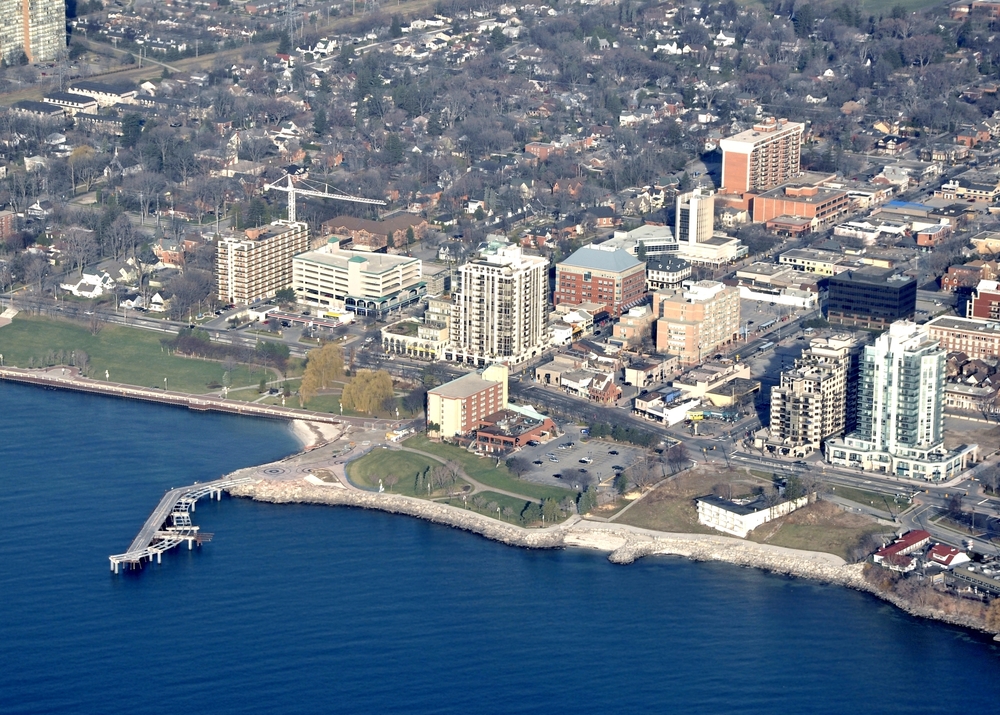 Is this skyline likely to change at all during the term of office for this Council? Forum Research will speak with the residents of 750 households as part of a community survey. Residents will be asked about city services, how involved they feel in city decisions, and how they prefer to hear from the city.
The phone interviews will finish by Feb. 19. This information will help City Council as it updates the city’s strategic plan for 2015-18.
 “I encourage everyone from across Burlington to help shape our future through the strategic planning process,” said Mayor Rick Goldring. “There will be many ways to get involved, including joining the Insight Burlington panel, weighing in on Let’s Talk Burlington or getting a group together to complete a strategic plan workbook. Watch for details about these opportunities on the city’s website “I encourage everyone from across Burlington to help shape our future through the strategic planning process,” said Mayor Rick Goldring. “There will be many ways to get involved, including joining the Insight Burlington panel, weighing in on Let’s Talk Burlington or getting a group together to complete a strategic plan workbook. Watch for details about these opportunities on the city’s website
In 2011, City Council approved the strategic plan, Burlington Our Future. The plan includes the vision “where people, nature and business thrive” as well as three strategic directions: vibrant neighbourhoods, prosperity and excellence in government.
For more information, or to get on the contact list for updates or involvement opportunities related to the city’s 2015-18 strategic plan, email ourfuture@burlington.ca or call 905-335-7600, ext. 7378.

 By Pepper Parr By Pepper Parr
January 20th, 2015
BURLINGTON, ON
It was pretty clear after less than five minutes that the four people short of capacity in city hall’s council chamber that Burlington wasn’t going for the ADI development proposal to put a 28 storey tower on the corner of Martha and Lakeshore Road.
The standing room only crowd heard one of the shortest Planning department presentations the Gazette has heard in some time. Planner Rosa Bustamante covered the basics of the project and that was it.
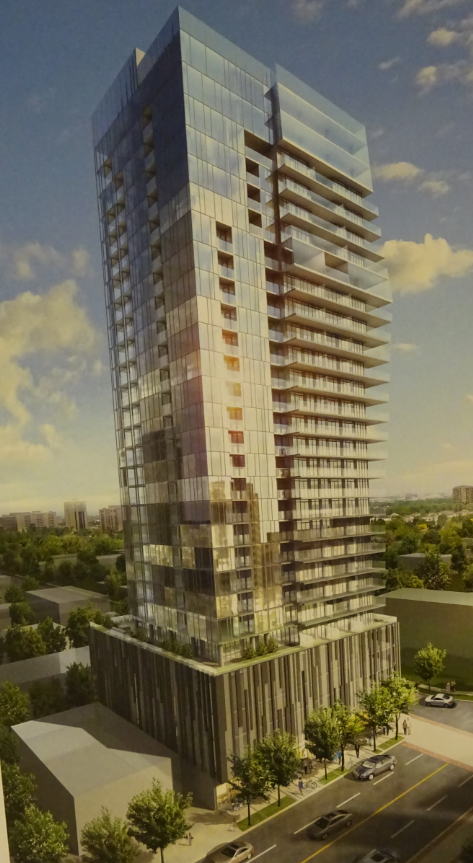 The scale and scope of a 28 storey structure on the corner of Martha and Lakeshore has astounded most people. Could it actually happen? Possible The event then moved into a Public Meeting at which delegations were heard. While the room was packed there were not all that many delegations.
Ward 5 Councillor Paul Sharman chaired the meeting; one got the sense that he thought it was being televised – he was certainly pumped.
There were no decisions to be made. It was a meeting to receive a report on the project from the Planners that outlined the basics – then the Public meeting which was required under the Planning Act.
Staff will now do a detailed report on the project and present it to Council – there may and there may not be a recommendation from Staff when they report.
Every member of Council was opposed to the project – but there were degrees of opposition. The project was described as “highly audacious” and “Over the top”
Councillor Craven said he was “not on for the proposal that is before us” leaving one to wonder what he was on for. The ADI Group is reported to have purchased land adjacent to the Aldershot Go station which is a part of Burlington that council wants to ssee developed as part of one of the mobility hubs that planners are working on.
Waterdown Road is undergoing a total rebuild from two lanes to five between Plains Road and Hwy 403 – this will be a major development and it looks at this point as if the ADI Group is going to be the major developer. Aldershot is ward 1 territory and Councillor Craven rules the roost over there. So he will become adjustable when it comes to deciding what should happen at the corner of Martha and Lakeshore in ward 2.
It was clear what the majority of Council thought, it was clear what the residents thought. The ADI Group planner saw it all quite differently.
His view was that provincial policy called for intensification and that the Big Move GO train project was put in place to move people around and that Burlington was one of the few growth centres left in the GTA – and while he didn’t actually say “’like it or not” this is what the province wants the ADI Group complies with the provincial policy.
 The red markers indicate where the ADI project would be built – two blocks west, on the waterfront the city has approved a 22 storey structure. As for Burlington’s Official Plan and its zoning bylaws – those things are in place – but they have been amended in the past and they can be amended – if not by City Council then by an application to the Ontario Municipal Board.
There was one number that got put on the table that puts the size and scope of the project into perspective.
The provincial target calls for 185 people per hectare of property. Burlington has set their target at 200 people per hectare which is what would go on the property if the four storey’s that the current zoning allows were built.
The ADI project would put 1661 people on that property. It is certainly audacious, over the top and outrageous but as Councillor noted “it is questionable that this Council will have any impact” on the final decision.

 By Pepper Parr By Pepper Parr
July 21, 2014
BURLINGTON, ON.
The Skyway Plaza, an east end commercial location that is as close to a suburban slum as Burlington is going to see, has suddenly become headline news – especially in ward 5, where Councillor Paul Sharman senses he might be facing a tough opponent in the October municipal election.
 Forlorn looking Skyway Plaza – looking for someone to save the place – but the owners seems content to leave it as it is. Has the Council member made the site an election issue? There is a basement bowling alley that hasn’t been used in years. There was once a Swiss Chalet; the Shoppers Drug Mart has a very faded sign and you’ll not have a problem getting a parking spot. To the rear of the plaza, there is a single pad arena that could use an upgrade.
Councillor Sharman has been doing everything he can for the past three years to get something going, but has gotten absolutely no traction with the absentee owner of the property. At one Standing Committee meeting, then city manager, Jeff Fielding suggested that the city could pool the property it has to the rear of the plaza and come up with a major development opportunity. What would it take to get to that point, asked Sharman? A staff direction would get us started, replied Fielding. But that wasn’t enough.
Sharman has made phone calls – dropped into offices in Toronto – nothing.
When Council went into a Workshop setting a week or so ago to look at ideas and opportunities to put some oomph into the commercial side of the city’s finances – Sharman was all over the idea of doing something with the best opportunity he has of raising his profile during an election year.
During that Workshop July 7th, mention was made of Community Improvement Programs (CIP). There wasn’t much more than a mention of CIP’s during the Workshop, but that mention was enough to get Sharman moving.
At the city council meeting of the 14th, Councillor Sharman put forward what Councillor Taylor called a Walk On motion, that few saw before it was actually presented. Sharman didn’t inform his colleagues – other than the mayor – but he did manage to get a majority of council to allow the motion.
Sharman explained in a telephone conversation. that getting the memo on the motion he had planned to put forward was left in the hands of the Clerk. Apparently planner Bruce Kruchelnicki was drafting at least a part of the document and was to send it along to the Clerk – who apparently failed to get it out to the other members of Council.
That comes pretty close to saying the dog ate my homework excuse – limp and lame if you ask me.
Much of the debate on the Sharman motion was at times contentious, if not nasty, but they managed to agree on a Staff Direction that went as follows:
DIRECTION REGARDING LAKESIDE PLAZA
Direct the Director of Planning and Building and request the Executive Director of the Burlington Economic Development Corporation as follows:
- Prepare a series of re-development options for the site based on intensive mixed use re-development and approach the owners of the property with the redevelopment plans; and
- Investigate and report on the authority available to permit the use of incentives for re-developing the site, and
- Provide an estimate of the resources needed to prepare and implement a Community Improvement Plan. (SD-23-14)
A Recorded Vote was requested by Councillor Dennison on the above recommendation, resulting in the following:
IN FAVOUR: Councilors Craven, Dennison, Sharman, Lancaster and Mayor Goldring
No one in Halton has done a CIP in more than 20 years; no one seemed to know all that much about the things – until Councillor Meed Ward informed Council that the downtown development group knew all about the things and that all they had to do was ask Special Business Area Coordinator Jody Wellings, who has been looking for ways to make a CIP work for the downtown core and Aldershot, but no one has actually asked Ms Wellings to do anything – yet.
Back in the 70’s and 80’s the provincial government made some money available for CIP type projects – but that tap got turned off and it isn’t likely to get turned on again.
However Wellings knows her stuff and she will get more than a chance to set out some of the potential at a meeting planned for tomorrow. Unusual for a team to get put together quite that fast. Is the force behind all this the Sharman Staff Direction or is it the EDC exercising some of the muscle it is supposed to have?
What was evident during the debate was the total lack of process – matters like this get brought to a Standing Committee, where input from staff enhances the debate. But that wasn’t the route Councillor Sharman wanted to take – he has an election he wants to win, and he needs an issue that puts more space between him and what looks like a strong contender.
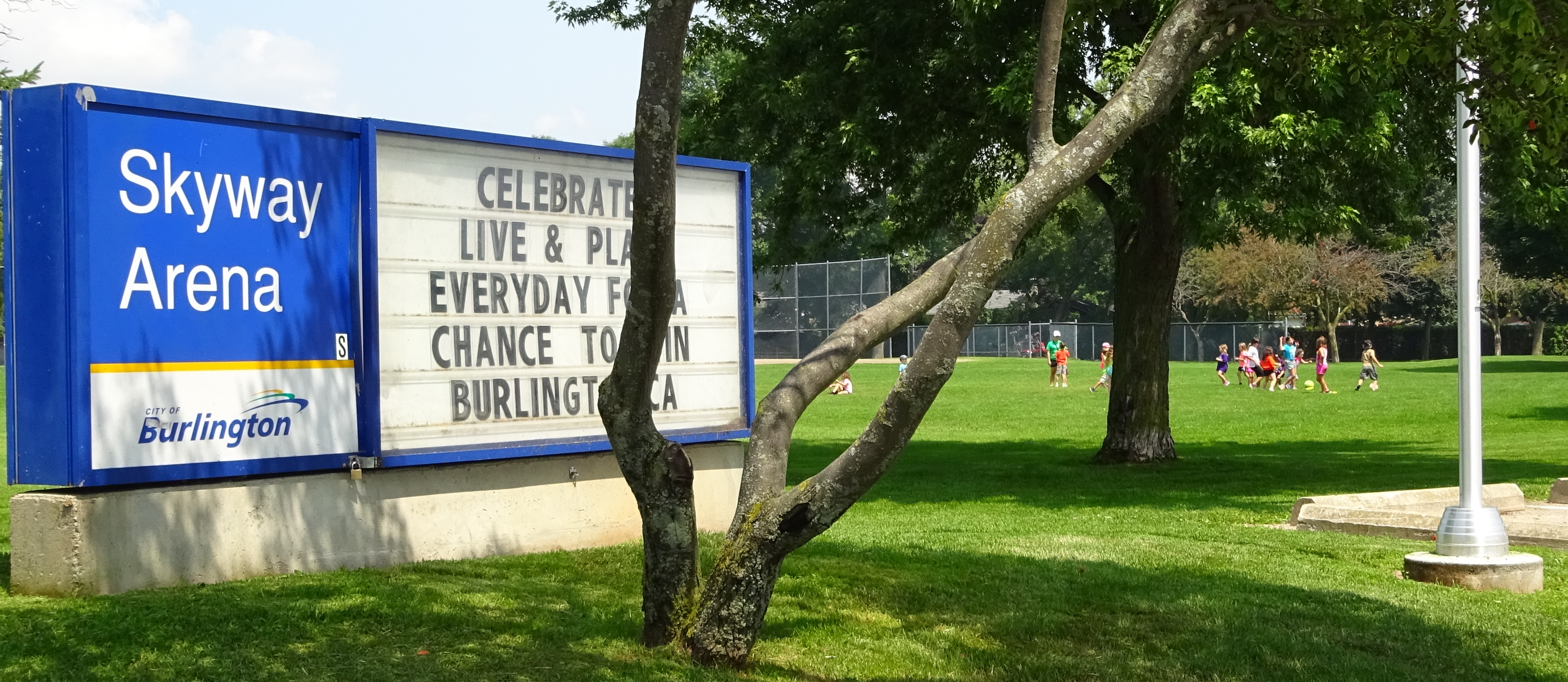 The city owned area, with a very large play field area is right behind the plaza – this is what the city hopes to attract developers to – possible? With discussion about spending money for community improvement elsewhere in Burlington on the table, Ward 1 Councillor Rick Craven mentioned that Aldershot likes the look of those Community Improvement Projects as well.
The reformed Economic Development Corporation (EDC) looks as if it is going to become the financial saviour of the city. During the workshop on the 7th – several references were made on how the EDC could work with the city and the role it would play in getting the Skyway Plaza situation fixed. Executive Director Frank McKeown was in the audience, but he wasn’t taking notes.
The EDC board met for the first time on the 15th – the day after Council approved the Staff Direction requesting that it jump into bed with the city on this one. Sharman is a city representative on the EDC board.
 The elephant in the room is the massive shopping centre planned for the other side of the Burlington/ Oakville border – blocks away from Skyway. Why all the fuss and bother over a Council Workshop and a Staff Direction? Burlington now knows that it cannot expect to pull in the kind of revenue it used to on development charges – it now has to expand the tax base on the Industrial, Commercial and Institutional (ICI) sector and it has reformed the EDC to make that happen.
The end run that Sharman did at Council before it rose for the summer looked like corporate shenanigans – not a good sign.
The expropriation done at Plains Road left at lot to be desired in terms of the way a property owner was treated. More on that on another day.

 By Pepper Parr By Pepper Parr
March 25, 2014
BURLINGTON, ON
There was a lot of energy lost, a lot of huffing and puffing as well as a lot of sometimes silly back and forth taking place yesterday at city council.
The Official Plan review is producing document after document which some members of council are finding it hard to keep up with.
The Planning department had distributed copies of two very significant reports; one was the final Phase 2 of the Employment Lands study and the other was a Commercial Strategy Study, it came in two parts, Phase 2 and Phase 3 reports.
Consultants were on hand to take council through the documents and we will report on what they had to say in a follow up report. Several members of Council commented that “these were weighty documents” and they needed time to fully understand and appreciate what was in the documents – and the contents were significant.
The team developing the documents that the public gets to see as part of the Official Plan Review has not produced very much on their progress – they have been busy getting the documents ready for distribution.
 During the phase the planners are in they hope – and they do have their fingers crossed, to achieve the following. Expect some slippage on the schedule – which is not necessarily a bad thing. During the phase the planners are in they hope – and they do have their fingers crossed, to achieve the following. Expect some slippage on the schedule – which is not necessarily a bad thing.
- “Full Launch” of engagement strategy
- Implement approved workplan
- Engage on the collective vision for the city and potential directions
- Gain deeper understanding of issues, questions and opportunities
- Identify and assess emerging directions to inform policy development
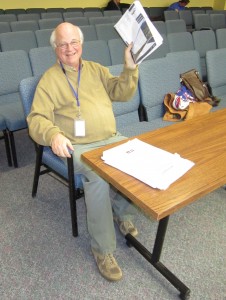 Ward 3 Councillor John Taylor is all smiles here as he waves three reports that were given to council yesterday; he wasn’t all smiles when he fumed at the overload and the time he wasn’t being given to read and absorb the content. Other council members said they too needed more time. Several council members were overwhelmed with the content and wanted more time to review the contents. The problem is that the OPR team is running up against problems with the calendar.
Council members want more time to review the documents; they also want to meet in what they call a Workshop setting where they can ask the consultants all kinds of questions and do what in the recent past has proven to be some very solid interaction where members of council learn and fully understand what is in the consultant’s reports.
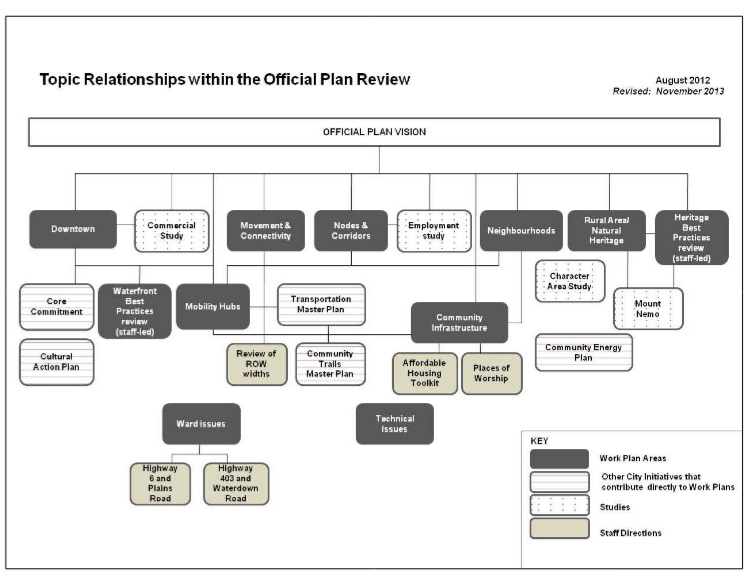
- The Official Plan Review team has a huge task on their hands and they have to juggle a number of research projects at the same time and manage to find time for real public engagement. The above sets out the projects that all have to be eventually pulled together to create what will become the city’s official plan for the next five years.
Traditionally, staff transmits documents to council that are then in the public domain. The Planning department then prepares its report on the consultant’s document and then that report – the one written by the planners – is debated at a council Standing Committee meeting.
This Council wants to change that approach. They want to hold a workshop at which they discuss the consultant’s report with the consultants in an open session. The Planning staff would take part in the workshop.
Then, after getting a sense of where the members of city council are going with their thinking – planning staff would write their reports that would include recommendations that council would debate and accept or reject.
The calendar and the time schedule that the OPR team have to work with is going to make this very tight. And, there are some professional concerns. The city has a well-paid and very qualified staff (those words came from the city planner – not me) and they have to be given the time to discuss and debate as planners what will work and what will not work for Burlington. The consultants are people we hire, explained Bruce Krushelnicki and we accept or reject what they suggest.
There is a tremendous amount of work to be done and some very hard thinking as well. These two reports are critical to how the city approaches its economic development. And without a significant change in its economic development Burlington as a city has some very real problems.
While the city figures out how it wants to handle the reports the people over at Paletta, who own the biggest chunk of those employment lands know what they want to do. In a letter sent to the city WHEN they said:
Paletta International Corporation (“PIC”), the owner of approximately 120 hectares of land located west of Burloak Drive between Upper Middle Road and Mainway, known as Bronte Creek Meadows (“BCM”). BCM has a long history which is known to many Councilors and Staff.
In their letter PIC disagreed sharply with the direction the consultants reports were going and said that BCM is not “part of a strategic concentration of employment lands”.
PCI said at that time, December 21, 201, that they were continuing to review some of the more technical aspects of the Draft Study but that “even at this early stage it is clear that the draft report is premised on a fatally flawed assumption; namely, that BCM is part of a strategic concentration of employment lands. In fact, BCM has no strategic locational advantages for employment purposes. It has no access to rail, no visibility to 400 series highways and relatively poor access to 400 series highways.
The document went on to say that PCI “has cooperated with the City in marketing the site for employment purposes for many years with no success.
As such, PIC does not support the conclusions of the Draft report in respect of BCM and will oppose any attempt to impose a secondary plan for employment uses on these lands. A secondary plan would be a waste of resources as the lands are not attractive for employment uses. A secondary plan will not change that essential fact.
Also included in the information given to council was a second letter from Paletta dated March 24th, 2014 in which they said they had serious problems with the “methodology and conclusions” used by the consultants. Clearly, Paletta had read the reports and figured out very quickly where there interests were being pinched. Why is it that the Paletta people can read faster than those on city council?

 October 14, 2013 October 14, 2013
By Pepper Parr
BURLINGTON, ON. James Ziegler, a 24 year resident of St. Paul Street was one of four people who delegated at a city council committee meeting speaking in favour of the city retaining the land it owns along the edge of the lake between Market and St. Paul Streets.
Ziegler is a detail person, he tends to look at the information put in front of him and interact with it rather than react to it.
After delegating and listening to what he thought were very short-sighted views he sent Councillor Sharman (Ward 5) a note which we set out below along with Sharman`s replies.
I’m writing with regard to Water Street properties and the recent committee meeting on this matter. I’m disappointed the committee’s motion on this matter and intend to provide additional comments and new information to support the merits of a Water Street walkway. Considering the nature of your questions it appears you may have a rather fixed view point and the valuation of this land. By your questions you appeared to be less interesting in considering an alternate point view and more seeking to elicit comments that would support a predetermined position. I believe there was a deficiency in objective facts on the matter and trust that you will listen to these with an open mind.
 You and your colleagues have chosen a short-sighted solution disregarding the need of future generations in Burlington for an expedient answer. I believe you have been bullied by the threat litigation and very narrow minded comments from the landowners. This does not represent the value of a potential park to the general community. You and your colleagues have chosen a short-sighted solution disregarding the need of future generations in Burlington for an expedient answer. I believe you have been bullied by the threat litigation and very narrow minded comments from the landowners. This does not represent the value of a potential park to the general community.
Should the council choose to sell this land, they are acting against several layers of adopted policy and I believe there are grounds for a class action lawsuit on the matter. A course of action I will participate in.
I was appalled by some of the comments of the landowners and some committee members. These statements demonstrated a sour attitude to the general population and lack of faith in the people in our community.
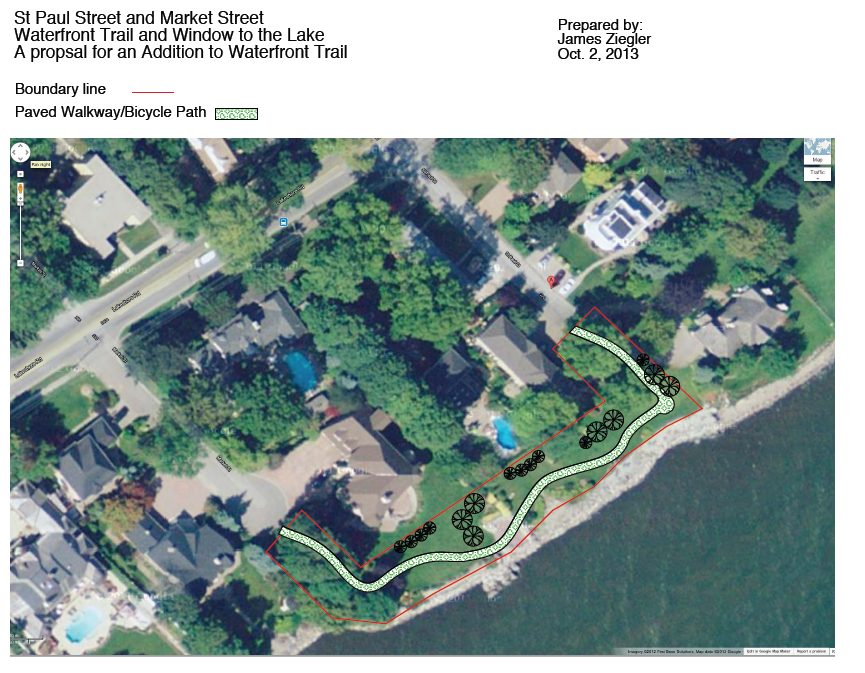 James Ziegler presented a graphic that illustrated where a paved pathway could be built and the proximity of a pathway to the three houses that abut property currently owned by the city. The property consists of three parcels: road allowances on each end and the old Water Street road in the centre. The city has voted, in principle, to sell the land in the middle. Reason for doing so appears to be financial and some legal history that the city does not want to talk about. This is a sad reflection of the community I live in. Councillor Mead Ward was the sole voice thinking of the value to the public at large about this matter. The paternalistic and condescending comments form Mr. Dennison and Mr. Taylor were a very poor display of public governance. In particular Mr. Dennison pacing the floor behind the chairs as Councillor Ward spoke to her motion could not have demonstrated any more clearly how he was fixated with his position and not willing to listen to any contrary idea. I don’t frequent the proceedings of council but was expecting better. (To be fair to Councillor Dennison, he frequently gets up and paces behind his chair – shouldn’t be seen as a reflection on what is being said or who is speaking.)
There were other citizens in the room for the committee meeting on Oct. 2 who did not rise to speak however they spoke to me afterwards and expressed their displeasure in the tone and attitude of the committee members.
Regarding the merits of a connected pathway, people on a run, walk or bike ride are far less likely to go out to a dead-end requiring them to turn around and follow back to the original line of travel. How many times on a run or walk have you chosen to back track on your route? Likely never or only when circumstances such as a closed path forced you to.
The cavalier comments regarding safety and potential malevolent behavior of some irresponsible people, made by the members and landowners were exaggerations intended to manipulate the argument based on fear. No evidence was presented to support these claims. Yet they appeared to be a significant factor in the decision. Applying the same criteria and comments made by the members most parks or large portions of parks in Burlington and in the Province should be closed to the public. There is no logic or facts to support these arguments. The police that I have talked to on this matter do not see this as a significant security problem. In fact the opposite is more likely true, a short walkway is safer and easier to manage than a dead-end. I have also talked to planners and landscape architects on this matter. The committee decision flies against progressive good community planning.
On the mater of parking for the area, this was a red herring, It completely missed the point, It is a walking pathway. I will present the council a map showing the populations served by the Water Street walkway, within a 1 km range. To suggest we (several thousand people, many in apartments and without cars) have ample opportunity to drive to Spencer Smith park or to crowd into the 50 usable feet of lake edge at Nelson Park to see the lake is akin to the Marie-Antoinette comment, “let them eat cake” People, the general population, need local access to the lake within walking distance of their homes.
I believe you and your colleges have grossly undervalued the significance of adding over 400 lineal feet of public access to the lake, compared to the existing 55 lineal feet of accessible frontage at Nelson park. You and others referred to this as excessive to put two parks between 3 houses. This is misleading to make a measure of scale by counting the three houses. I’m sure you will agree the three houses are much larger than the average size house and lot size in the Burlington core. A better measure would be to look at the real dimensions.
Please reflect on the real motive why you voted against the Water Street walkway and take another look at the matter. As I said at the committee, consider this generation and the next three generations that can enjoy the Water Street walkway. Consider what kind of city you are contributing to. The Vision in this regard should be thought of in terms of many decades not the short term fiscal issues. At the very least leave the land available to a future council with a greater vision for the public welfare. This I use in the true sense of the word, faring well in mind body and spirit.
James Ziegler
 Sharman, the Councillor for Ward 5 responded with: Mr. Zeigler: Thank you for your email. I appreciate your thoughtful and considered argument. I am curious to hear how you feel about Ms. Meed Ward’s position on not acquiring the properties on the Beachway for park, and perhaps even selling vacant lots to private owners? The fact is that there are inconsistencies in all of the arguments, that is normal because the devil is in the details. Sharman, the Councillor for Ward 5 responded with: Mr. Zeigler: Thank you for your email. I appreciate your thoughtful and considered argument. I am curious to hear how you feel about Ms. Meed Ward’s position on not acquiring the properties on the Beachway for park, and perhaps even selling vacant lots to private owners? The fact is that there are inconsistencies in all of the arguments, that is normal because the devil is in the details.
 Ward 5 Councillor Paul Sharman is usually very direct, tends to want to see data that is verifiable and expects to get his way. I understand the higher level motives behind your argument, and in principle I agree. In my experience, in theory everything is practical, in practice it is not. Water Street needs to be resolved now, punting the decision to a future time is simply not helpful. We have parks we don’t maintain. And while I would love to have a path along the waterfront, the properties with riparian rights in the area of Water Street will not allow for further extension of such a pathway.
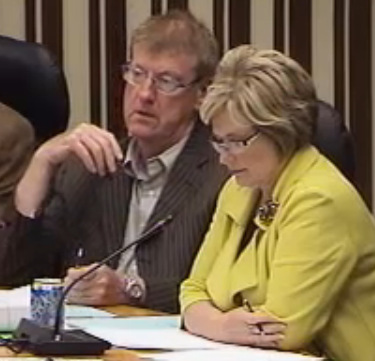 Councillor Sharman with Councilor Blair Lancaster. Sharman has dug himself into an ideological argument that he probably cannot get out of. Lancaster liked the sound of leasing the land and might be convinced to change her vote. Each opportunity is evaluated on its own merits. The Water Street properties do not need to kept by the City just to satisfy a higher level ideology. The City policy is clear about acquisition of waterfront property when it is practical and logical to do so. Your view and that of Ms. Meed Ward versus the views of 5 of my colleagues and I are different. It happens.
 Sharman is an avid cyclist. Were he to cycle through the pathway Ziegler proposes he would in all likelihood pause along the path and marvel at the view and tell himself – this is why I am a city Councillor of this city. Besides, I am concerned that the location is so obscure that very few people will actually benefit, apart from the malcontent youth. The proposal is to have two parkettes and to maintain the existing park 200 yards away. That will work quite fine. The City does not need to spend a pile of money to satisfy just a few people. We have bigger matters to address.
Paul
Ziegler probably took in a deep breath after the Sharman response but soldiered on and replied with:
Dear Councillor Sharman: Thank you for your reply. I’ve forwarded your comments to my neighbours. I don’t consider this a matter of ideology, for myself and my neighbours and our families it is a very practical matter. This in not in the realm of conceptual notions. It would be an aspect of many people’s daily lives.
I hope we will be able to convince you that this walkway will be a significant contribution with the potential to be enjoyed by many. I see that you have some challenges to appreciate the importance of creating a 400 ft. walkway. It will be linked to the walk along Lakeshore and the fact that adjacent lands will not be available makes it all the more important to create portions that are accessible.
You may not be a frequent walker or runner so you may not appreciate the value of a linked pathway. I hope my friends and neighbours will help to change your opinion.
James Ziegler.
Later in the weekend Ziegler passed along several of the graphic illustrations he plans to use during his delegation on Tuesday evening.
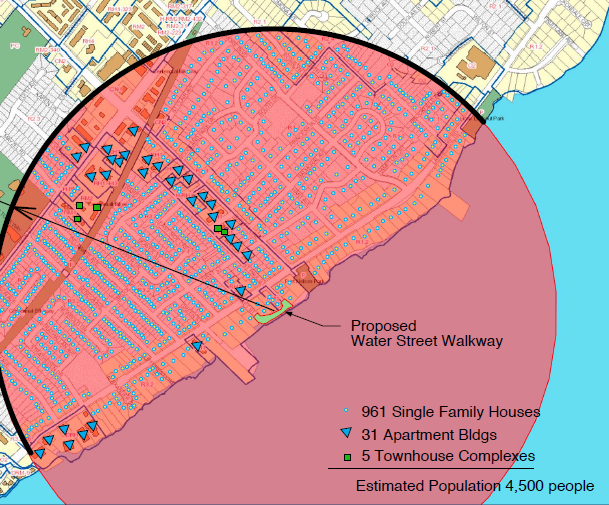 There are an estimated 4500 people within a 100 metre radius of the pathway James Ziegler proposes be created along the edge of the lake between Market and St. Paul Street. He then takes on the view that there aren’t that many people in the immediate area who would use the pathway parkette that is proposed and provides a graph to make his point.
Ziegler and his neighbours realize that they face a steep uphill battle. Meed Ward is close to despondent – she just doesn’t see a 4-3 in favour of keeping the land or leasing it. She would need three more votes – the Mayor is a possible, Lancaster is a possible as well. Craven would rather die than vote with Meed Ward and both Taylor and Dennison see the revenue that a sale would being and they want those dollars for infrastructure work.
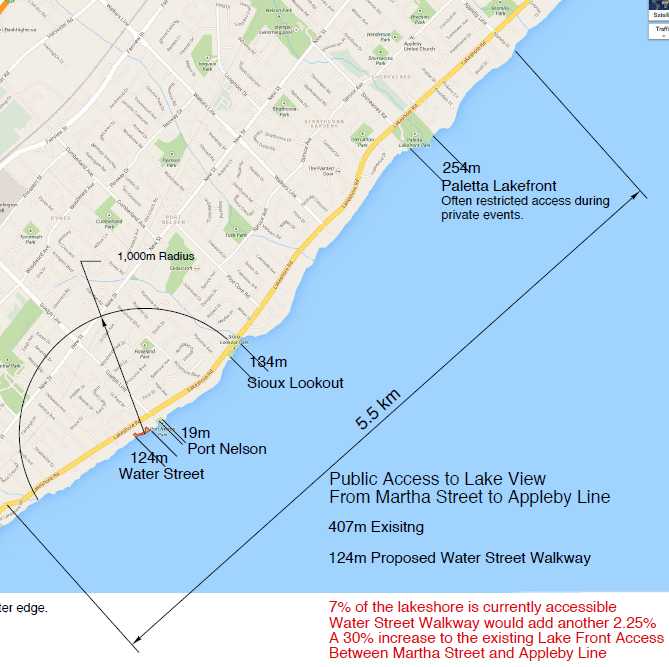 Several council members went on about the amount of park space on the eastern side of the city. The Water street property is one of the few areas where parkland can be created. The western side of the city has much more park space. Will these arguments make a difference?

 September 12, 2013 September 12, 2013
By Pepper Parr
BURLINGTON, ON. The residents in the Beachway Park have won their battle to keep their homes. At the Community Services Committee of Council, during a mammoth session with more than 20 delegations, Council was given information that some of them just did not have.
Information that Council members should have dug out more than a year ago was brought to the surface by some of the most impressive delegations this reporter has heard in the last three years.
City hall staff were prepared for an overflow crowd and had set up speakers in an adjoining room. While the Council chamber was packed – there was room for everyone.
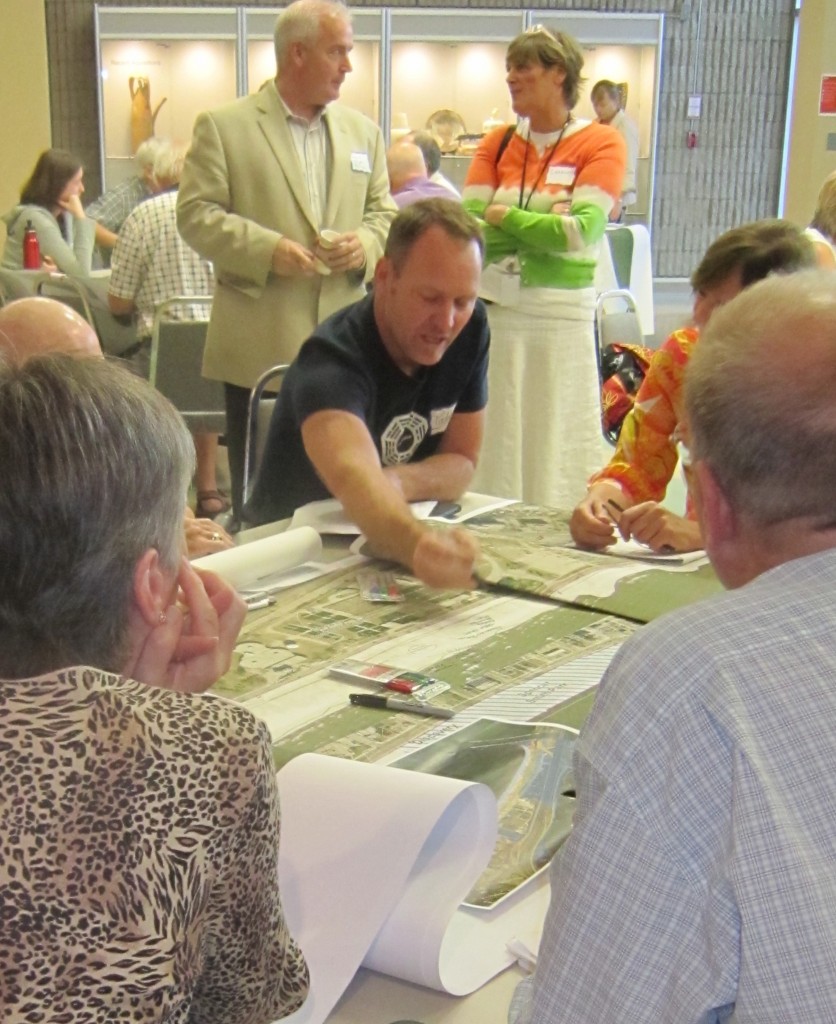 Community meetings, lobbying, challenging city hall positions eventually paid off. Here residents talk about the Beachway community as they wanted to see it continue.
On a very sad note, the woman in the orange and green sweater, Charlotte O’Hara Griffin, a long time city staffer who was involved in the Beachway project, died earlier in the week. She would have smiled at the results. A couple of the delegations were at the podium for extended periods of time while complex matters of property titles, willing buyers and willing sellers and zoning were given a thorough going over.
What was clear is that a determined, focused and persistent electorate can bring about changes in early drafts of city policy.
 Laura Durant, on the right, and her husband Glenn Gillespie, center, talking to a meeting facilitator who was prepared to evict them from a meeting. These two were a consistent and persistent part of the community effort to see a change in the minds of city council. It was a full evening and there is a lot to tell. Four points stick out: (1) the draft of a motion Councillor Dennison clearly plans to present, details below; (2) the excellent comments lawyer Katherine Henshell made when she demolished the myth of a willing seller and a willing buyer situation that council members and staff at both city hall have bandied about; (3) the comment Real Estate agent Betty McMahon made when she said the value of property in the Beachway will jump 50% when the zoning mess is cleared up – and finally, this is true: (4) Councillor Craven, whose behaviour was less than sterling was seen being escorted to his car by the security staff. Who was he afraid of?
In the dying minutes of a four and a half hour meeting Dennison read the following: Recognize the continued existence of the residential community as adding value to the park experience and Update the Official Plan and zoning to reflect low-density residential.
Authorize the Director of Parks and recreation to work with the Halton Region and Conservation staff to complete a concept plan, environmental management plan, and detailed design for the Beachway Park component of the Burlington Beach Regional Waterfront Park that focuses on land already in public hands; build a plan based on existing publicly owned lands, with the exception of former residential sites in between private homes on either side of Lakeshore Road. Offer these sites for sale.
Authorize the Director of Parks and Recreation to send correspondence to Halton Region requesting that Halton`s Regional Council support the city of Burlington`s “Vision” for Beachway Park and authorize regional staff to work with the City of Burlington and Conservation Halton on an implementation plan focusing on lands already in public hands.
Dennison told the audience that he had three other Council members who would support his motion when it is formally presented. Councillor Meed Ward and Councillor Taylor will be onside. It was not immediately evident that the Mayor was one of the three but expect him to jump on this wagon very quickly.
On this issue a plan, that was never really a policy but was always thought to be what the city would eventually do, was beaten back. The will of Council responded to the wishes of the people – backed up by some solid data and even sounder common sense.
The Council Committee will resume their deliberations Thursday afternoon at 1:00 pm. They could lose the will that was evident last night and have a change of heart – which would set this city up for a battle royale at city council September 23rd.
It was a good night for the city of Burlington. We will report in more detail on this story once council completes its committee session. We understand Councillor Craven got home safely.

 By Pepper Parr By Pepper Parr
BURLINGTON, ON. April 8, 2013 It was a rambunctious meeting. City Council was preparing to vote on a decision made in committee to approve the Ghent Avenue development that will have 58 townhouses going into a space that formerly had 8 houses on it. More than 100 well-developed trees would be cut down
It was controversial when it was discussed in the community; it was controversial when it was discussed at council committee and it was no less controversial last night – it still passed – but not before council went into one of its longest closed sessions.
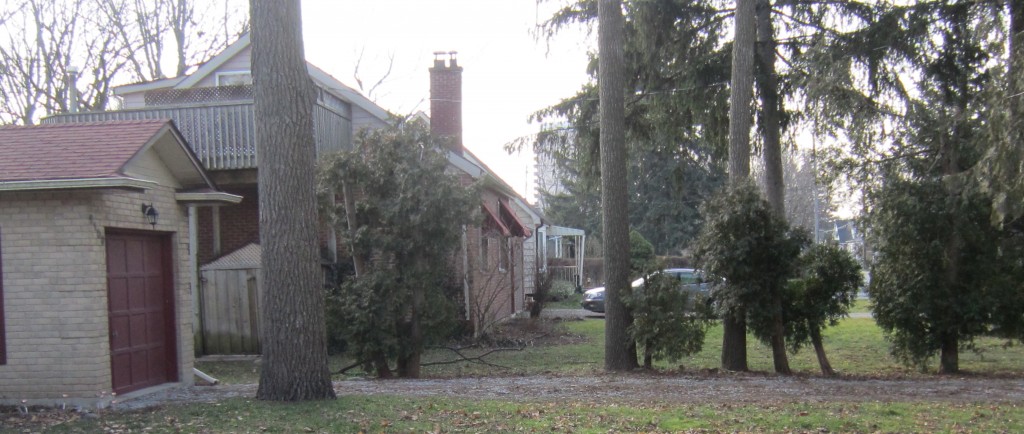 Several of the houses that were bought up for the development that has 8 such homes being replaced by a townhouse project with 58 residences. Council knew this was not going to be a popular decision. At the committee level it had asked for a legal opinion on the chances of this matter being appealed to the Ontario Municipal Board (OMB). If Council decided to go against the Staff recommendation the city was certain the developer would take the matter to the OMB. If Council approved the development the city felt the residents might appeal to the OMB.
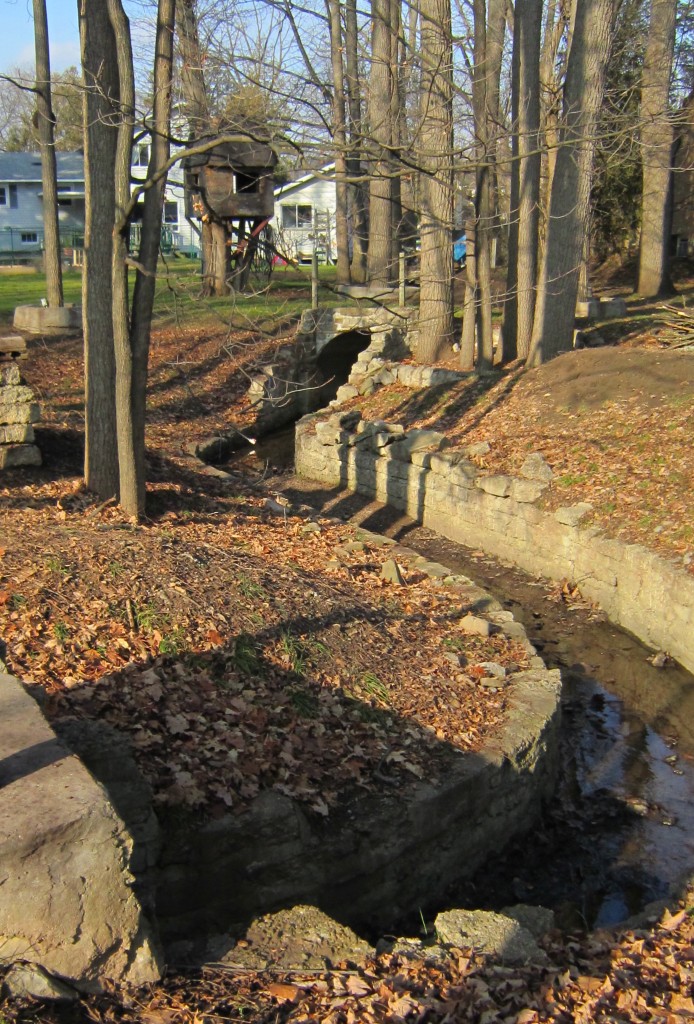 Rambo Creek, which runs along the eastern edge of the properties assembled, was a point of considerable discussion as to how flooding would be controlled – the city was never quite on top of that issue either. 
 By Pepper Parr By Pepper Parr
BURLINGTON, ON. April 3, 2013 – The first hint that there were going to be neighbourhood character studies was when the Planning department held a very small workshop at the Performing Arts Centre where they gave three groups of people the same very large map and asked them to define the neighbourhoods on the map.
Each of the groups came up with vaguely similar boundaries but there really wasn’t much in the way of a clear expression of just what a neighbourhood was. Little wonder: according to Alan Gummo, formerly with the planning department and now retired, the word neighbourhood doesn’t appear in the Official Plan, a document the city was setting out to review as required by provincial legislation.
The city’s Planner had decided the 2013 review would be much deeper than past reviews, doing so for a number of reasons. Bruce Krushelnicki now had Provincial guidelines he had to adhere to and he had a much more robust Strategic Plan to adhere to as well. That document was crystal clear in its viewpoint – there were to be “vibrant neighbourhoods” and while that concept has been used to slip through some pretty dodgy spending, there was no getting away from the fact that it was something that had to be dealt with.
If there are to be vibrant neighbourhoods the planners needed to know just where those neighbourhoods were located.
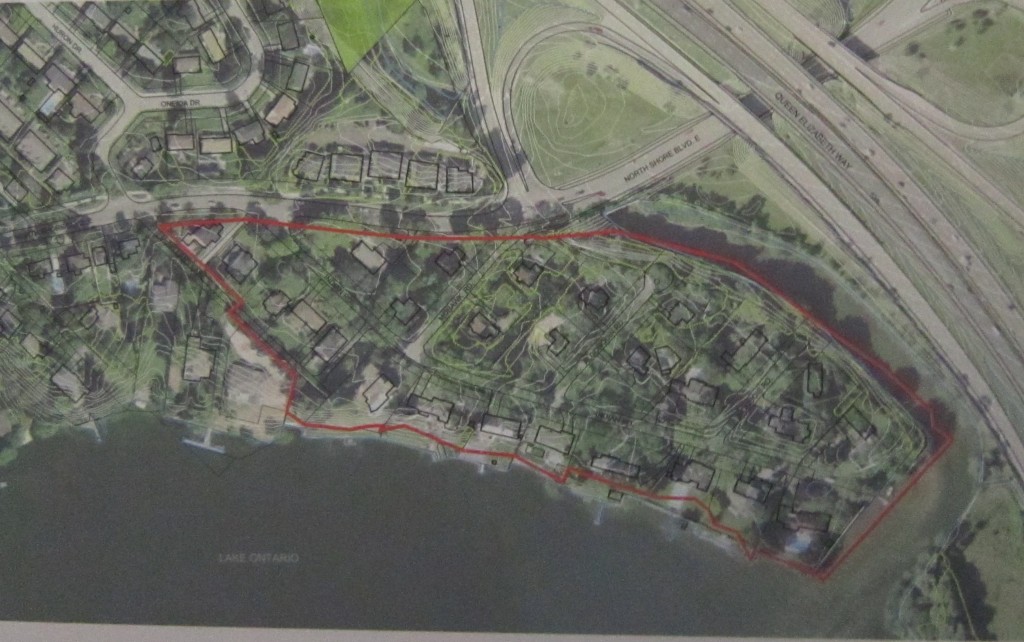 Fifteen acres, 30 homes, three streets are all part of the Indian Point enclave felt to be the oldest neighbourhood outside the Burlington core. Krushelnicki explained to the residents from Indian Point Tuesday evening, that Burlington was a core city that just added neighbourhoods as it evolved. Indian Point was probably the very first neighbourhood that got described as an “enclave” with 30 properties that were made distinct by large lots bounded by a creek on the north and Lake Ontario on the south.
Aldershot evolved. Roseland came into being, Millcroft, the Orchard are a few of the others that followed. The most recent is Alton Village that came about when the 407 was built which created a piece of land that was no longer north of the rural boundary. Other than some housing to be included in the Tremaine Road/Dundas development in the eastern part of the city and the Eagle Heights development in the west, the city is pretty well-built out and as Krushelnicki put it “we now have to better manage what we have.”
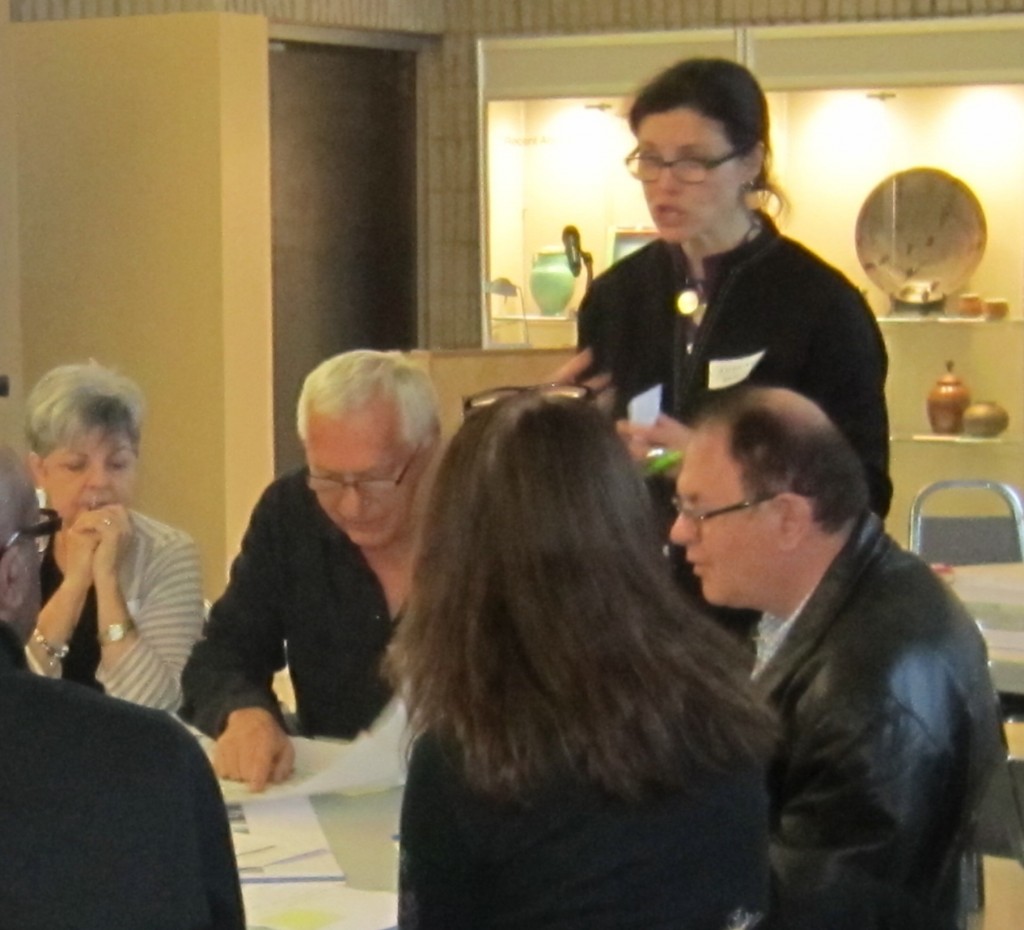 Anne McIlroy, standing, talks to Indian Point residents about their views and vision for the community that is part of an Official Plan review character study. 
 By Pepper Parr By Pepper Parr
BURLINGTON, ON. March 4, 2013 This stuff is as dry as toast and watching paint dry is more exciting BUT, it is the stuff that is going to result in the foundation your city gets built on.
In Burlington, the Capital Budget is a ten-year rolling document. They plan ten years out and advance the decisions each year. This year there are so many things in a state of flux that the city manager advised Council he will want to re-state the Capital Budget very soon. The intention is to align the Capital Budget with the Strategic Plan. Burlington now has a thoroughly thought out Strategic Plan that came out of more than five days of meetings spread out over a three-month time frame. It was what council and staffs were able to do at the time – the city might be ready for a review of that plan – perhaps in the next term of council.
So- what is it that’s on the table from a Capital spending point of view for the city in 2013?
Well the Tyandaga Golf course is not seen as a revenue generator for the city and the land could, some think, be put to better use. The city manager isn’t prepared to stake his reputation on these numbers but he thinks the club needs 23,000 new people every year to replace those that don’t return. He adds to that, the view of many golfers – that the club just doesn’t cut it as a fine place to play the game.
Ward 1 Councillor Rick Craven argues that the place could be managed better and they could think in terms of recreational uses during the winter months – like allowing cross-country skiing and maybe even an outdoor skating rink. So – what does one do with that land? Just asking was what we thought we heard the city manager saying.
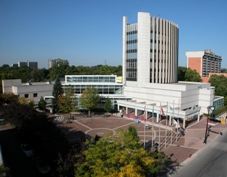 Will we see additions made to city hall or will the site be sold to a developer – or perhaps the building could be torn down and turned into a parking lot? City Hall is getting a very close look. The city currently rents space in the Simms building directly across the street from city hall and that lease is up in 2016. Legal and Finance are in the Simms building and it is not uncommon to see staff walking across Elgin Street with their arms full of documents. Some are advocating for putting additional space on top of what already exists at city hall, while others think selling the building and putting up a brand new city hall is the better direction to go in.
When the suggestion about doing something with the city hall was put out, Ward 1 Councillor Rick Craven immediately suggested that Aldershot would be an ideal place for a stunning building. Has he put a feeler out to the Paletta’s?
The sense was that if a new city hall were to be built it should be in the downtown core but no one identified what the boundaries of that core would be. There is the space in the parking lot four between John and Elizabeth Streets that the city has been hankering to do something with for some time.
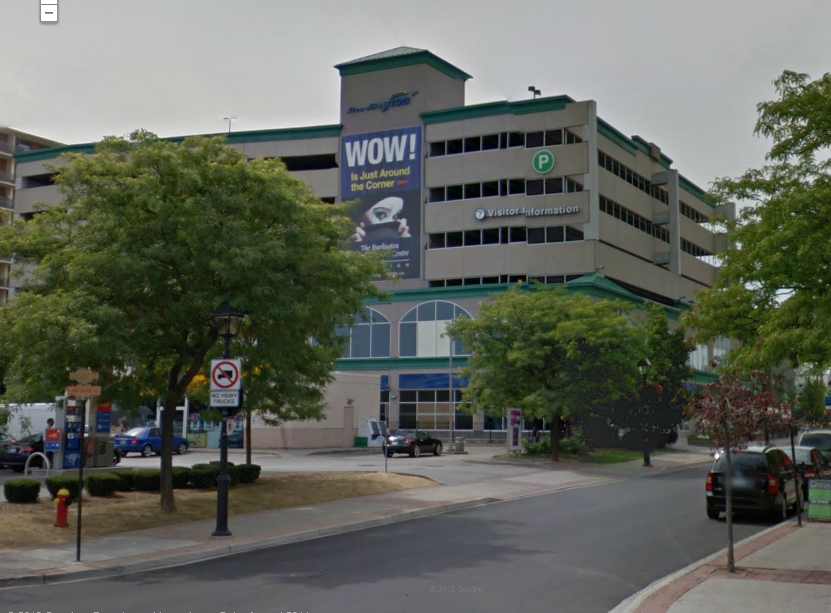 Here’s a WOW for you. Tear down the parking lot, put up a condo – then tear down city hall and build the parking lot on Brant at Elgin. Put commercial space at the ground level. Where would city hall go? Over on parking lot # 4 om John Street. – and while you’re at it put the Burlington Arts Centre in the same building as well. The capital budget meeting at which ideas like this got tossed around was quite the meeting. Is Burlington ready for this kind of growth? Now try this idea on for size. One of the city’s general managers asked: Why do I park my car in a building that is close to overlooking the lake. The parking lot on Locust Street immediately south of the Performing Arts Centre is on pretty prime property. What if that parking lot structure were torn down (yes it is fairly new) and the land sold to a developer for another condo much like the others spread out along Lakeshore Road? Great views of the pier and Spencer Smith Park from that location.
Then tear down the city hall building and put the parking lot in that location. What would the net cost be? Councillor Dennison pointed out that what the city has spent in rent could have paid for an addition to city hall. The city needs more space for its staff who are currently in two buildings on opposite sides of Elgin Street.
Whatever is built on that lot would be a multi storey building – think maybe 10 to 12 stories and could house the Burlington Art Centre collection on two – maybe three floors. The ground floor would have all kinds of open space with the different guilds working away at their crafts that the public could look in on. The world-class collection of Canadian ceramics could be on display and visible to the public. They are currently in cardboard cartons in a storage vault.
The land the Burlington Art Centre is located on – Lakeshore Road across from Spencer’s on the Lake would be sold and have condo sites on it. That BAC lot is very, very deep – something exceptional could be built on that property.
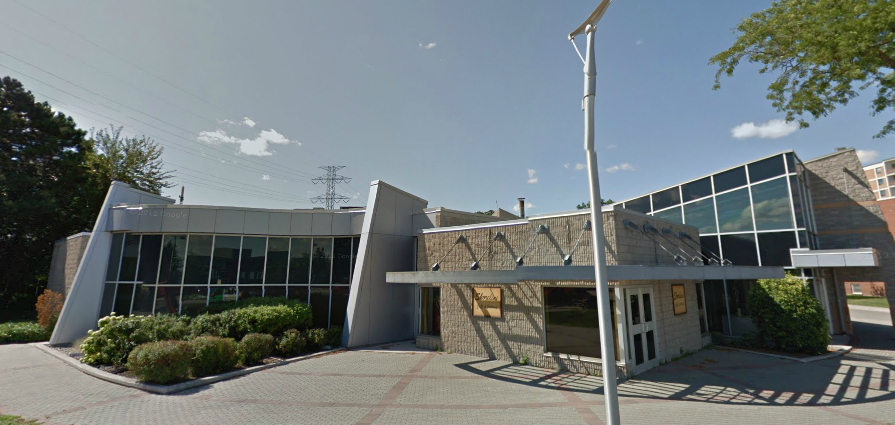 The Burlington Art Centre sits on some prime lakefront property. The land is said to be worth $6 million and the Centre needs more space for its ceramics collection. Maybe there is a better place for the BAC? Perhaps in a new city hall built on parking lot #4 on John Street? The BAC needs more than $4 million in upgrades to get their structure and HVAC up to scratch. Some thought there was merit in selling the current BAC property, said to be worth $6 million for the land alone, and moving the Art Centre to a building that will go up on that parking lot everyone has eyes on but no one wants to invest in.
There were some pretty heavy ideas floating around. It got better. The city manager has noticed that the Hydro property on Brant near Upper Middle Road is a large piece of land that, to use the language of planners, is under-utilized. It is much bigger than Hydro will ever use – there are ideas floating about as to how that property might be put to better use.
The city is about to take a closer look at what it wants to do with the Beachway part of the city. The first steps in that process are finding an entrepreneur who wants to put something commercial in the old Pump House. One young lady delegated to a council committee meeting and said she wanted to talk to the city about using the space to rent bicycles and paddle boats to people during the summer season. If she adds a patio where Councillor Dennison could enjoy a glass of wine she’s got his vote.
 The sign is the brightest thing about the shopping plaza. The Skyway Arena in the east end has just a single ice pad which isn’t seen as very efficient. When this came up during the capital budget discussions the city manager asked how much tolerance the city had for risk and would Council give any thought to considering the idea of trying to make something out of a possible combination of the arena property, the library that is currently using rented space on Fairview and attempting to work out something with the owner of the Lakeshore Plaza that is in dismal shape?
No sooner were the words out of the mouth of the city manager and Councillor Sharman piped in with: “Consider it done and that resulted in a staff direction on which council can expect there to be a lot of push back from the residents of the community.
The Lakeshore Plaza is a bit of a dump with almost as many “For Rent” signs as there are actual occupants. The Swiss Chalet is closed. The theatre and bowling alley haven’t been used for years and the place has that sad, run down look about it.
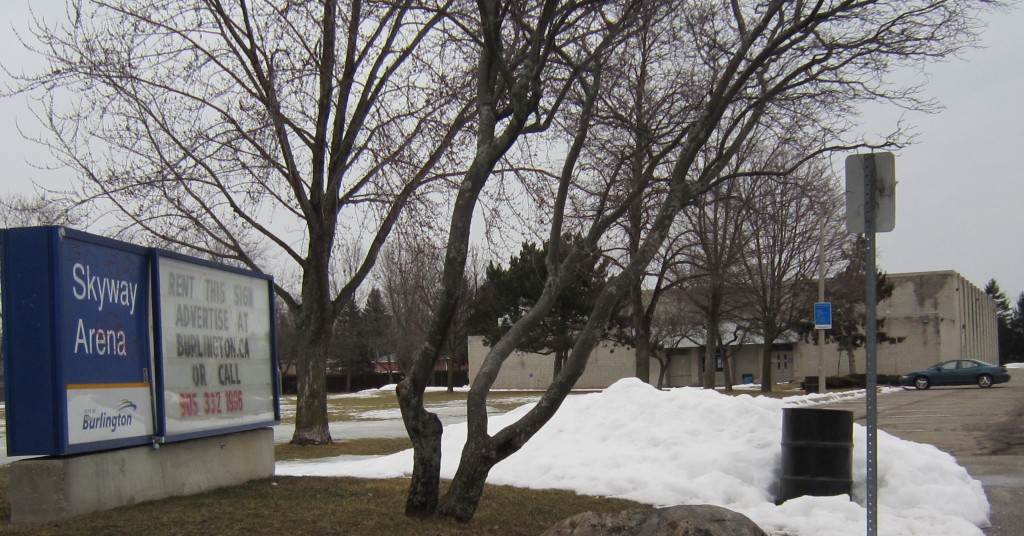 A too small to be economically viable – the Skyway Arena is getting a close look from the ‘bean counters’ at city hall. The city manager thinks there are some development opportunities. The local community wants to be at the table if there are any deals made. Could get interesting. The Skyway Arena sits at the back of the plaza property – which is what got the city manager to thinking – what if the city made its property available to a developer and asked anyone interested to come up with some ideas.
Combining the Arena space and the Lakeshore Plaza properties would create a very enticing development opportunity. The Skyway rink is currently a single pad which the city finds very expensive to maintain. Two pads are much more economical.
Were a developer to come up with some housing ideas that would accommodate families – the city could create a community out there that would anchor the east end of the city, create a new community that would have access to the arena, that could be enlarged – add to that the immediate access to Burloak Park – and there would appear to be a win-win situation for everyone.
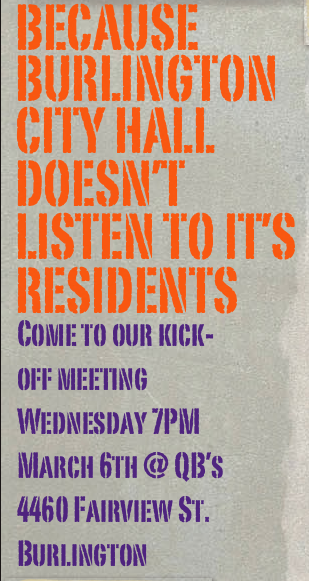 Save the Skyway arena didn’t lose any time getting the word out and making sure city hall knew who they were. Is their Ward Council member aware of the group? During the discussion Councillor Taylor, whose turf is in the north-west part of the city, piped in and suggested to his fellow council members that the community needed to be included in all this grand plan thinking. That point seemed to have gotten lost.
It didn’t take long for the residents of the community to stand up on their hind legs and begin to bark. Before you could say “Bob’s your uncle”, a group had a web site up with a headline saying “Because Burlington City Hall doesn’t listen to its residents” .
So, while the capital budget itself is a pretty dry document consisting of how much gets spend on roads and then which roads, and then how many buses does the city buy and what size of bus – some of these decisions are for something that is going to happen eight years out. Difficult to get people excited about what is going to get done that far out into the future.
What all this is leading to is a much more entrepreneurial look at the way the city develops its capital spending. Those longer term spending decisions determine the shape of the community we get to live in.
Way back in 1985 city council approved a development on Lakeshore Road that is only now at the early stage of actual construction. That decision approved a structure that will reach 22 storey’s into the sky line – something few people in this city fully appreciate. Will it loom over everything or will it add to the skyline. When the debates were taking place back in 1985 it was seen as a “landmark” building – will the community see it that way when it opens?
In her last delegation to city council the late Jane Irwin reminded them that many called the place BORINGTON. That just might be about to change.

 REVISED REVISED
We erroneously reported that the $50,000 cost of the Mayor’s One Dream event was paid for bu Emshih Developments. The event was paid for by 12 organizations of which one was Emshih Developments whp donated $5000. The Molinaro Group, another developer with projects before the city also donated $5000.
Our apologies to the Mayor for the mistake we made.
By Pepper Parr
BURLINGTON, ON February 27, 2013 We are back into Inspire mode with the Mayor announcing there will be a series of speakers during 2013.
This next speaker Dr. Pamela Blais to speak to us about Perverse Cities: Hidden Subsidies, Wonky Policy and Urban Sprawl.
Blais is a city planner and principal of Toronto-based Metropole Consultants. Her professional focus is in creating better cities by integrating planning, economic and environmental thinking in the analysis of urban issues, urban design and the development of innovative policy. She is particularly interested in understanding key forces that drive urban development patterns, and how to shape urban form so as to maximize its ability to effectively meet current and future trends. Her approach to urban development issues aims to be strategic and integrated.
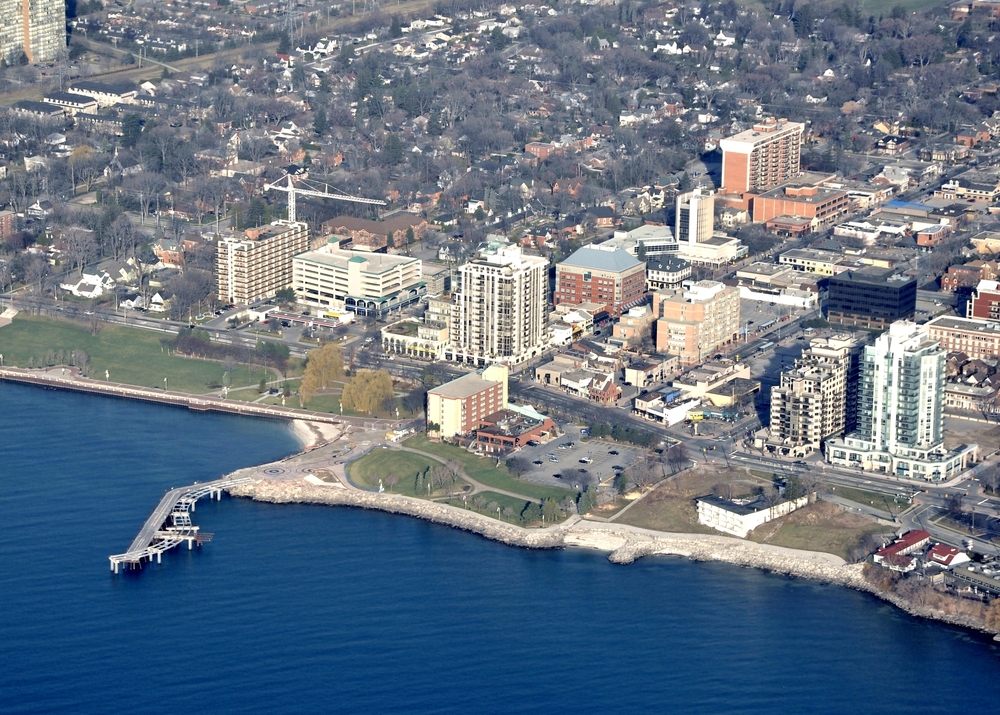 Will we hear some really good ideas from Pamela Blais at the Mayor’s Inspire event? In the past a number of his council members have been notably absent from these events. In her twenty year career as an urban planning consultant, her work has included reurbanisation strategies and research; long-term regional growth planning; municipal economic development strategies; innovative land use policies for industrial areas; urban regeneration strategies; sustainable urban form, community design and infrastructure; and research on the impact of technology on urban form.
Blais has a Master of Science degree in Planning from the University of Toronto, and a Ph.D. in urban economic geography from the London School of Economics. She is a Registered Professional Planner, and a member of the Canadian Institute of Planners.
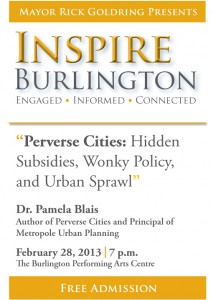 Those are pretty good credentials. Blais will be the eighth speaker in what is a very impressive series – the mayor is to be congratulated on this initiative. By sponsoring these events he has upped the quality of debate and discussion in this city – something that was badly needed. Those are pretty good credentials. Blais will be the eighth speaker in what is a very impressive series – the mayor is to be congratulated on this initiative. By sponsoring these events he has upped the quality of debate and discussion in this city – something that was badly needed.
There is a concern however. When the Mayor Goldring brought in Lance Secretan that encounter resulted in what was at first called a Defining the Dream initiative that then got renamed to: One Dream – which appears to have died – at last we’ve not heard anything since the Mayor announced he would be getting back to the community late in January.
The initiative appears to have died after some $50,000 was spent pulling together some 30 people who weren’t able to get past square one.
All that full day event saw was our MPP, Jane McKenna going after the editor of the Burlington Post for the way she handled news items. Had former Mayor Walter Mulkewich not been in the room and managed to get a grip on the way things were going the meeting might well have melted down.
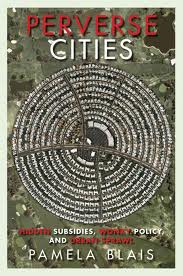 The Mayor put out a bit of a report and said there would be more in January – so far not a word. We now learn that more than $57, 500 was spent on this event – with a portion of that amount coming from two developers ($5,000 each) with major interests in the city. Not a healthy place for any politician to be – especially the mayor, who by the way had not publicly announced where the funding came from. The Mayor put out a bit of a report and said there would be more in January – so far not a word. We now learn that more than $57, 500 was spent on this event – with a portion of that amount coming from two developers ($5,000 each) with major interests in the city. Not a healthy place for any politician to be – especially the mayor, who by the way had not publicly announced where the funding came from.
Hopefully we will hear a solid presentation on some of the follies that get attached to development charges and approaches municipalities take to taxing their residents. Hopefully Blais will inspire the audience and get the Mayor and his council thinking about new approaches to how we manage the growth of a city that is at a crucial point in its growth. Please – no more cock-a-mammy ideas Your Worship.

By Pepper Parr
 BURLINTON, ON May 28, 2011 – Burlington is one of a few cities that makes use of Section 37 of the Planning Act. Ottawa, Toronto and Markham use the provision which can be a very useful planning tool. In Burlington we are fortunate to have a planner who wrote the definitive text on the Ontario Municipal Board and a man who has served as a member of that Board. The significance of this is that most matters that go to the OMB are related to planning matters and to have a planner who knows the ins and outs of the OMB as well as the intent of the Board gives Burlington an intellectual advantage. BURLINTON, ON May 28, 2011 – Burlington is one of a few cities that makes use of Section 37 of the Planning Act. Ottawa, Toronto and Markham use the provision which can be a very useful planning tool. In Burlington we are fortunate to have a planner who wrote the definitive text on the Ontario Municipal Board and a man who has served as a member of that Board. The significance of this is that most matters that go to the OMB are related to planning matters and to have a planner who knows the ins and outs of the OMB as well as the intent of the Board gives Burlington an intellectual advantage.
 The way Section 37 of the Planning Act is implemented just might get a re-working in Burlington if Council members follow up on their comments. Section 37 of the Planning Act relates to situations where an Official Plan calls for a certain type of development. It could be single detached housing, row housing organized as a condominium or a high rise, inevitably the issue become one of density. How many units can you put in a piece of property ? The municipality’s Official Plan (OP) will set out what the density can be and the zoning on the piece of property will set out what kind of building can be built on the site.
There are occasions where a developer will approach a municipality with a proposal that exceeds what is set out in the OP, but after discussions with the Planning Department, agreement is reached that the proposal is “good planning” and meets both the immediate and long term needs of the city.
We had two instances of just that happening in Burlington very recently and both created significant opposition within their communities. One was a condominium development south of the Queensway and the other was the apartment/condominium development at Brock and Elgin. In both instances the city approved an amendment to the Official Plan to permit the development
Burlington is faced with a provincial requirement that we grow our population. The province tells us that is what we have to do and that is what we do. The provincial Places to Grow legislation requires Burlington to grow its population by 20,000 people over the next 20 years – that’s 1,000 new housing units every year.
Because the city no longer has very much “green space” to build large projects on they have to resort to intensification.
Developers see opportunities to take land that is being under utilized and they begin to assemble properties until they have an area large enough for the plans they have in mind.
In the Queensway area this resulted in a developer purchasing six properties that consisted of half an acre each. These lots were created at the end of WW II and known as Veterans Land Act properties. Once the land was assembled the developer asked for permission to build a 74 unit complex on the property and the local community was up in arms. That development eventually got cut back to 58 units but is still a significant bit of intensification – going from six homes to 58 on the same pieces of land.
In the Brock Elgin area the developer did an assembly and came to the city with a proposal to increase the density permitted in the Official Plan from 7 to 14 storeys. The community was aghast and argued against the development at two public meetings and a third meeting at a Council Committee and finally at a Council meeting. They were beaten back at every meeting.
In this instance the developer made a Section 37 proposal in which the city determines how much the value of the land the development is being built on is going to increase due to the development.
Note that the unit of measure here is the increase in ‘value of the land’ not the revenue and potential profit the developer expects to see. The city gets an appraisal of what the land was worth before the development and what the land will be worth after the development and then asks the developer to contribute half of the increase in value back to the city as community benefits.
In the Brock Elgin development the increase in the value of the land was deemed to be $1 million and the developer agreed to pay for community improvements worth $500,000.
This is seen as a way for a city to share in the gain that a developer earns when asking for and getting an amendment to an Official Plan. Sounds fair and is seen as a sound planning practice.
Where people in Burlington get really wound up is how the community benefits are determined. The Planning department does all that thinking – with not a peep from the community. Ward 2 Councillor Marianne Meed Ward thinks this is wrong and fought vigorously to have the community involved in determining what the benefits should be.
She came close to getting her Council colleagues to look at what was being proposed then, to the surprise of just about everyone, they learned that if Council wanted to make any changes to the community benefits the matter had to be sent back to Committee.
Several Councillors believed that the amendment to the Official Plan and the applicable by law could be approved and the specific make up of the community benefits looked at later – wasn’t possible. The two had to be approved at the same time.
Section 37 of the Planning Act is a very sound and accepted planning tool. What Burlington hasn’t done is bring the community in on the process and get their input before deciding what to do.
Councillors Sharman and Taylor have said they want to see the community benefits issue handled much differently. We will be watching.

|
|
 By Pepper Parr
By Pepper Parr

























 This change is about the kind of building projects we’ll see built in Ontario and how we will pay for the stuff we build. I suspect that members of Burlington and other City councils who subscribe to the failed dogma of Libertarianism won’t like this legislation one bit. To them I say: “suck it up princess, the free ride is over”. Specifically these Planning Act Changes propose to:
This change is about the kind of building projects we’ll see built in Ontario and how we will pay for the stuff we build. I suspect that members of Burlington and other City councils who subscribe to the failed dogma of Libertarianism won’t like this legislation one bit. To them I say: “suck it up princess, the free ride is over”. Specifically these Planning Act Changes propose to:



 If passed the Bfast people (Burlington for Accessible Transit) will burst with Joy! – and probably have to have Pacemakers installed to still their beating hearts.
If passed the Bfast people (Burlington for Accessible Transit) will burst with Joy! – and probably have to have Pacemakers installed to still their beating hearts.













 “I encourage everyone from across Burlington to help shape our future through the strategic planning process,” said Mayor Rick Goldring. “There will be many ways to get involved, including joining the Insight Burlington panel, weighing in on Let’s Talk Burlington or getting a group together to complete a strategic plan workbook. Watch for details about these opportunities on the
“I encourage everyone from across Burlington to help shape our future through the strategic planning process,” said Mayor Rick Goldring. “There will be many ways to get involved, including joining the Insight Burlington panel, weighing in on Let’s Talk Burlington or getting a group together to complete a strategic plan workbook. Watch for details about these opportunities on the 









 You and your colleagues have chosen a short-sighted solution disregarding the need of future generations in Burlington for an expedient answer. I believe you have been bullied by the threat litigation and very narrow minded comments from the landowners. This does not represent the value of a potential park to the general community.
You and your colleagues have chosen a short-sighted solution disregarding the need of future generations in Burlington for an expedient answer. I believe you have been bullied by the threat litigation and very narrow minded comments from the landowners. This does not represent the value of a potential park to the general community.
 Sharman, the Councillor for Ward 5 responded with:
Sharman, the Councillor for Ward 5 responded with:





























